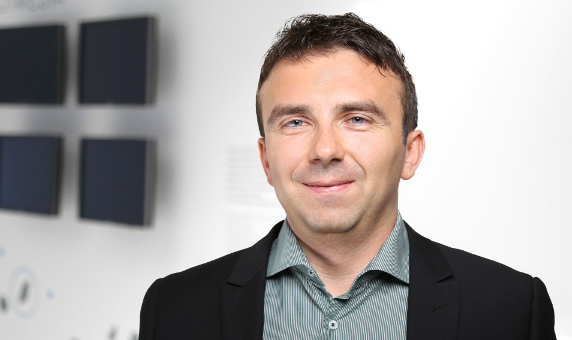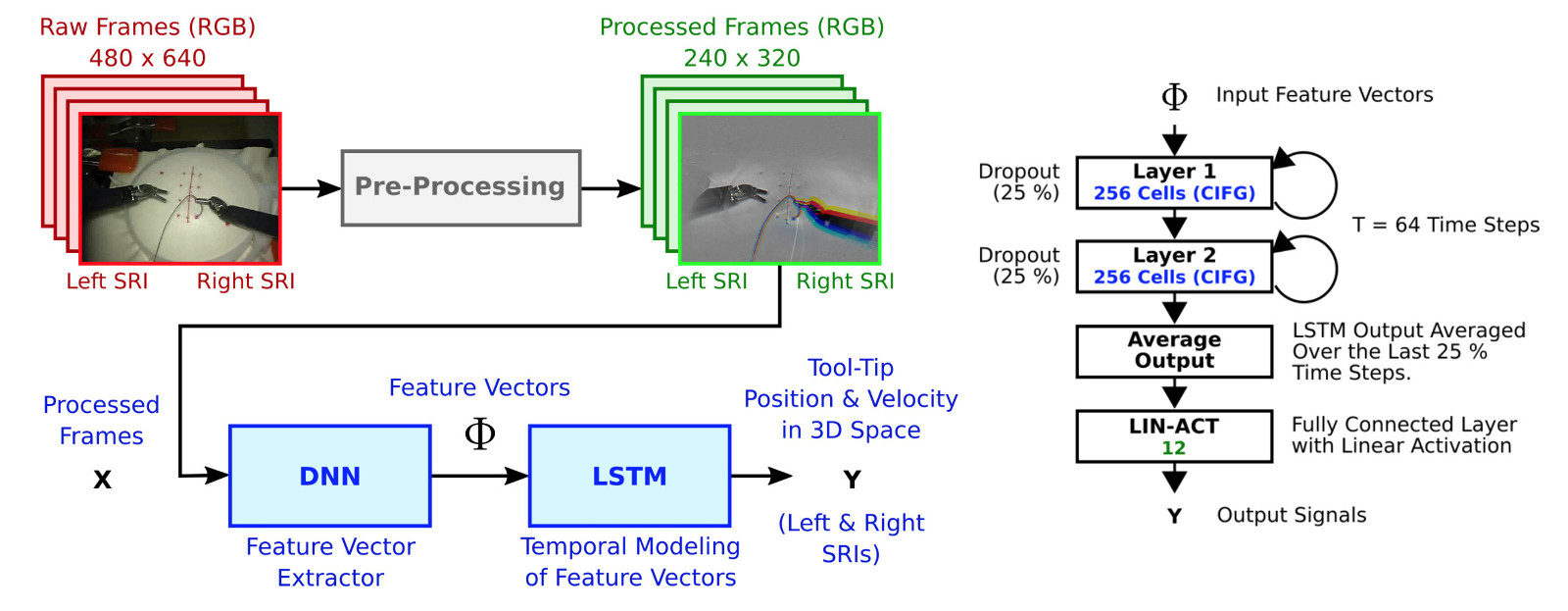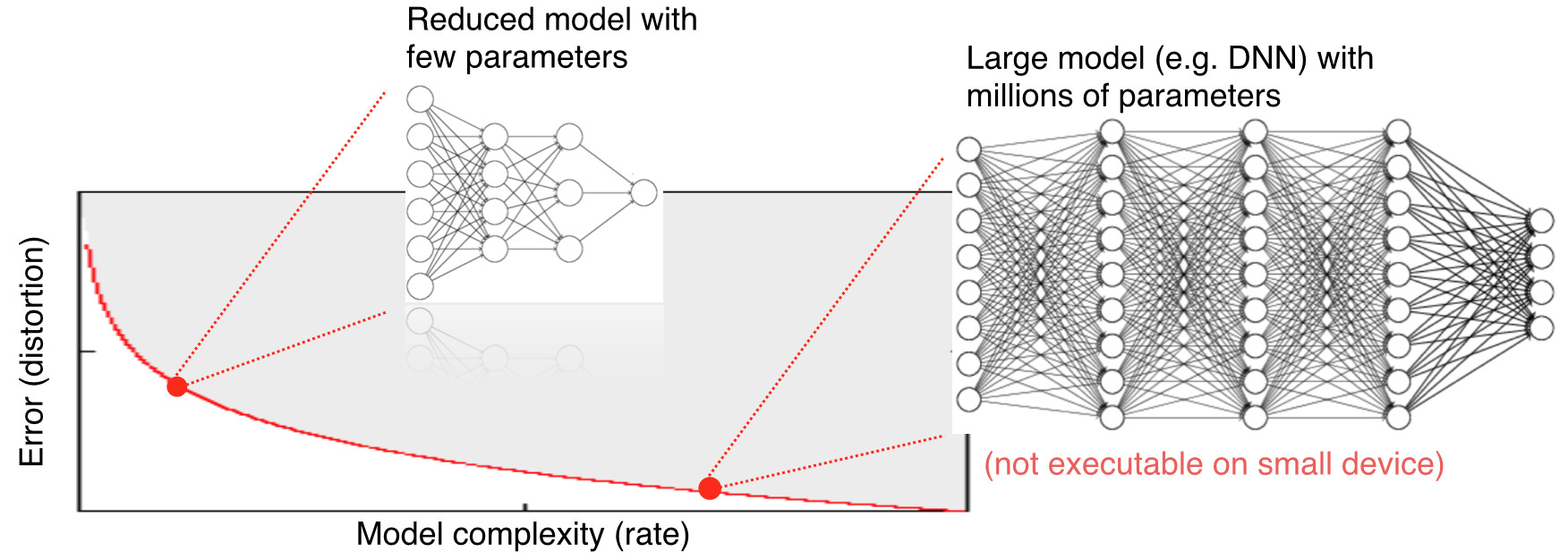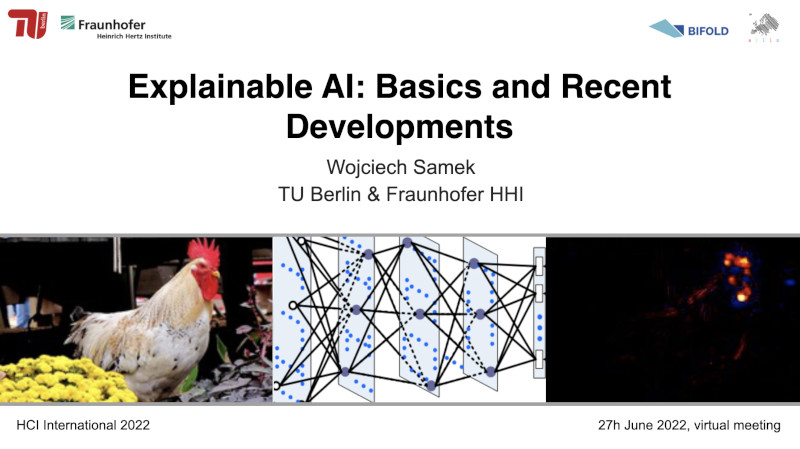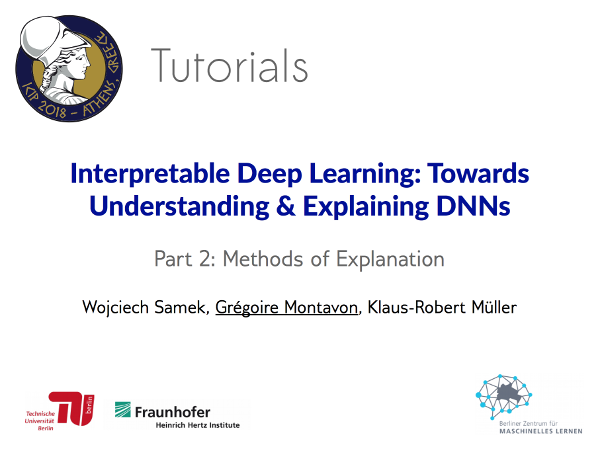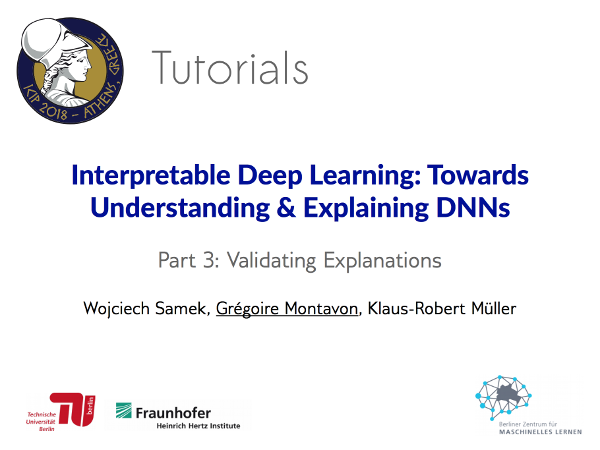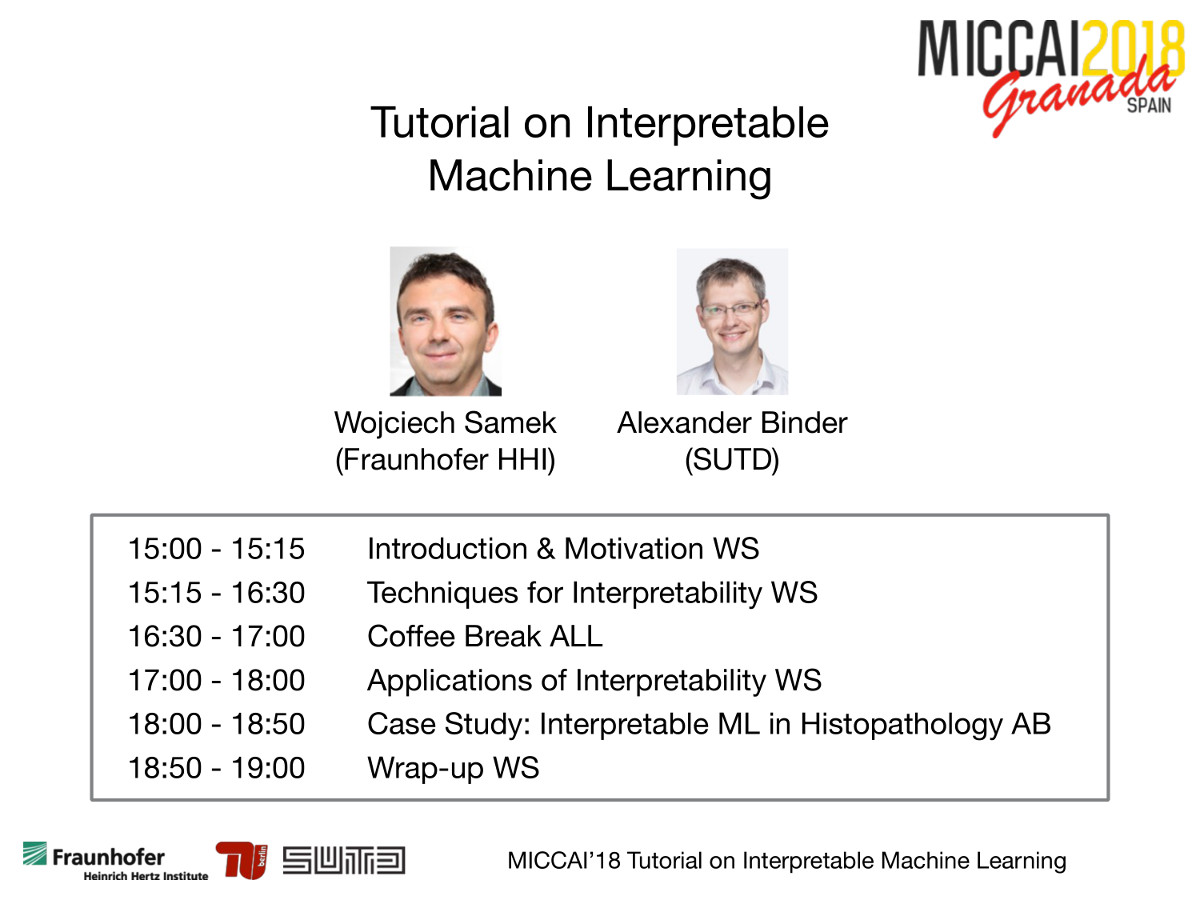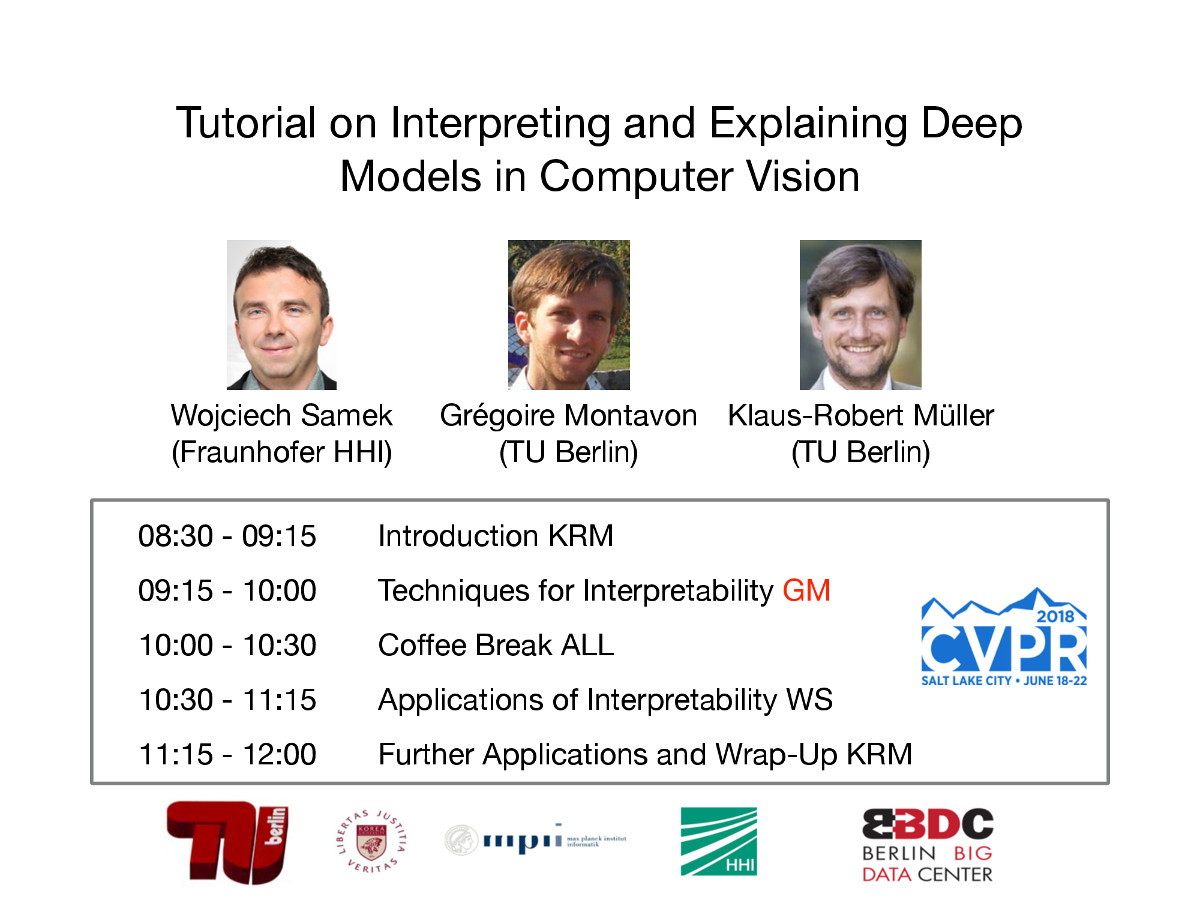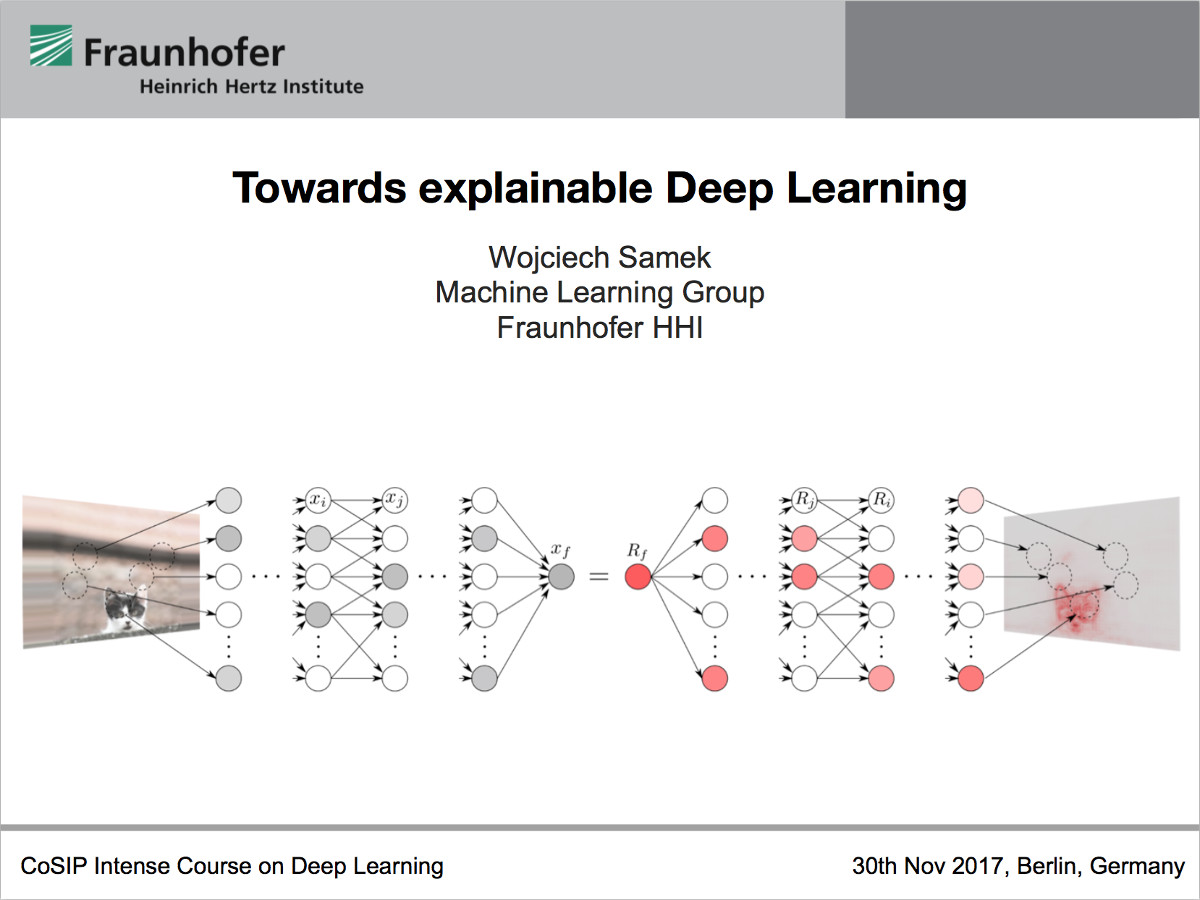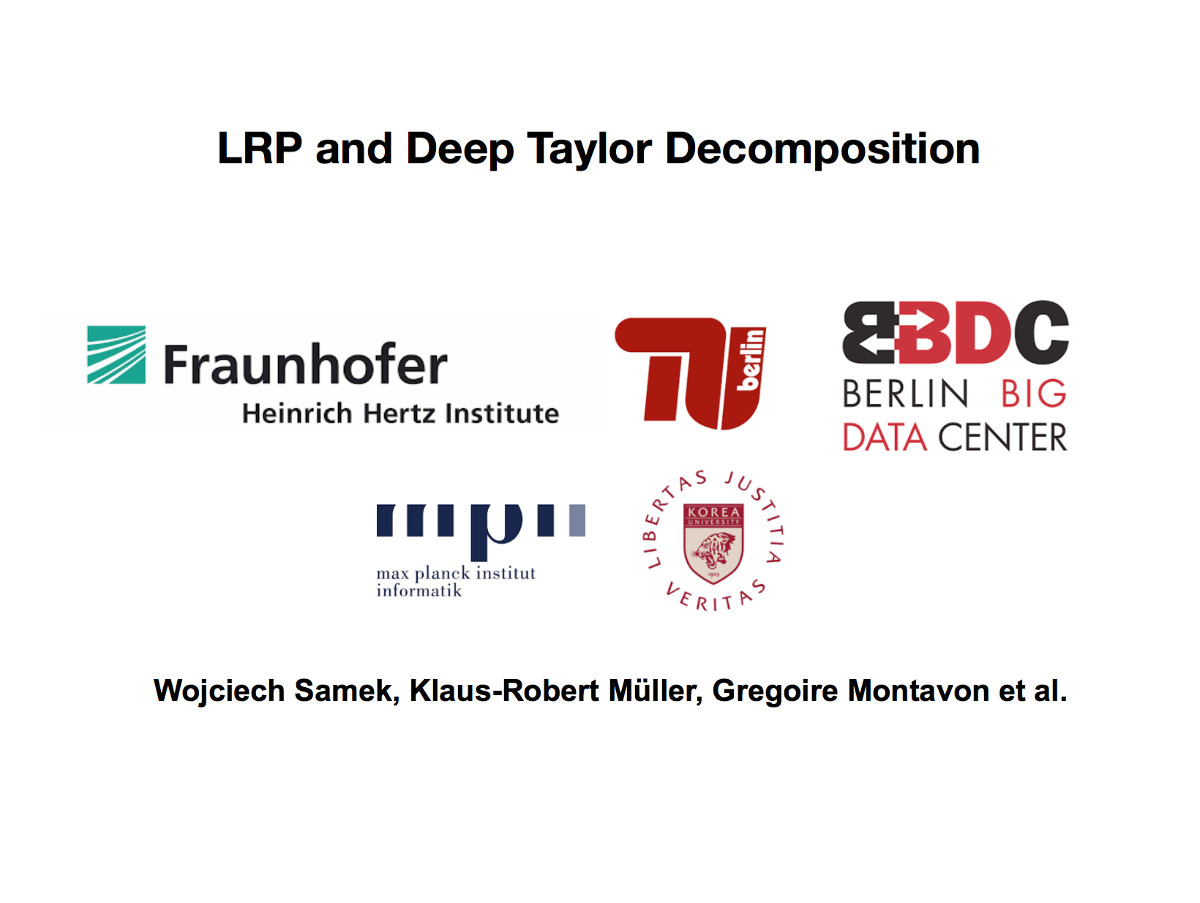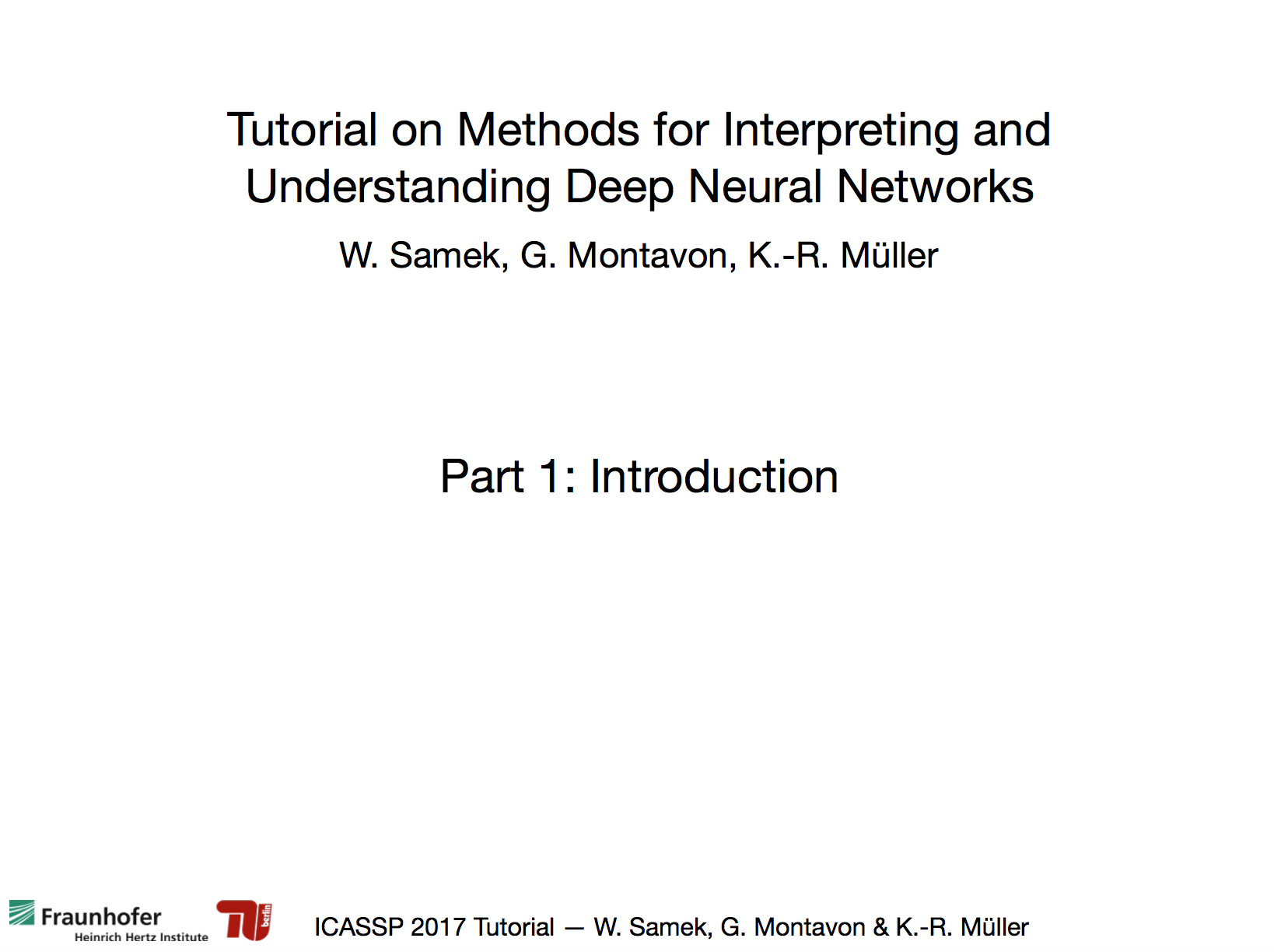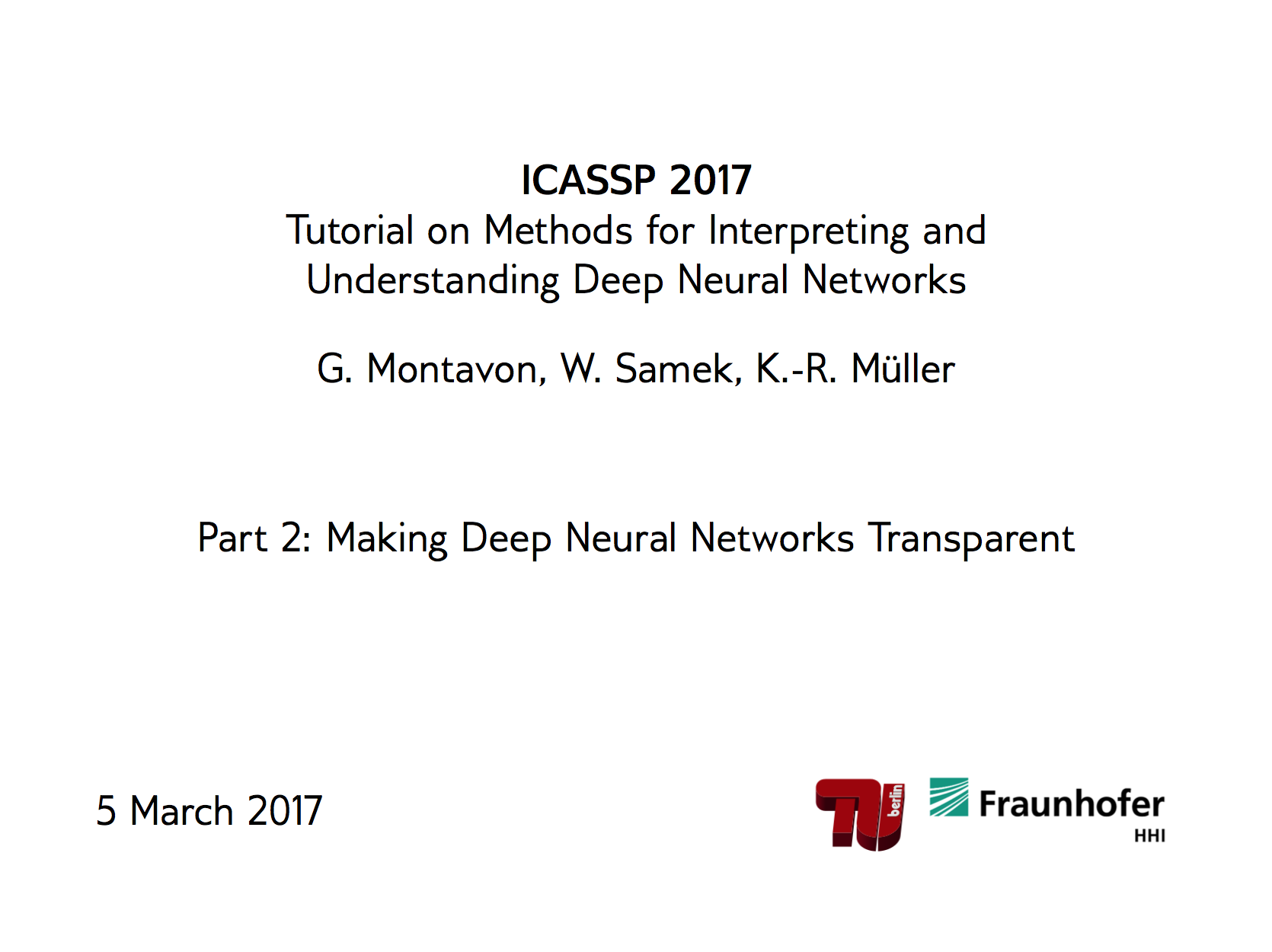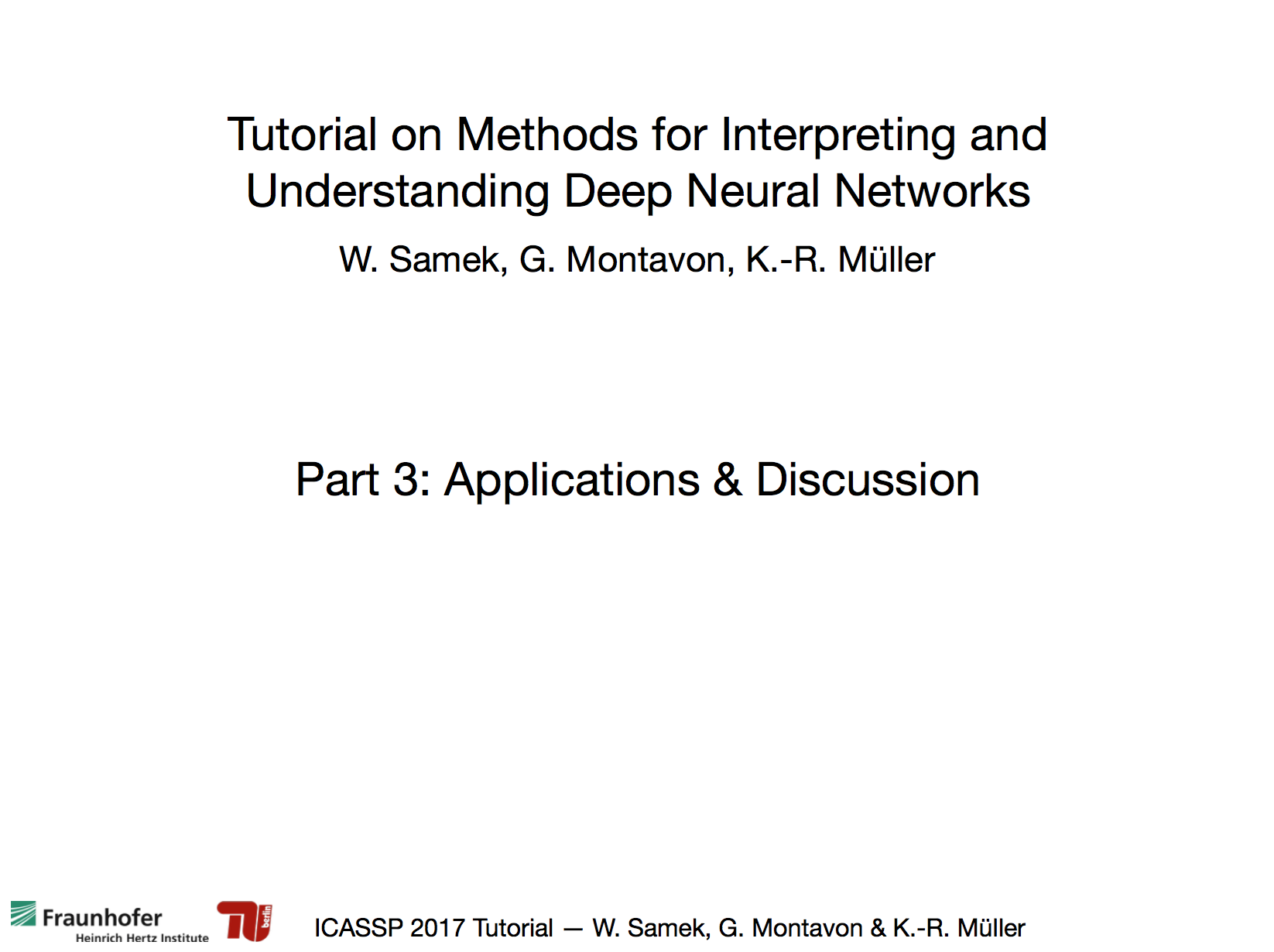| | | |
Preprints
| 8. | Galip Ü. Yolcu, Thomas Wiegand, Wojciech Samek, Sebastian Lapuschkin:
DualView: Data Attribution from the Dual Perspective
arXiv:2402.12118, 2024
[bibtex] [pdf] [url] |
| 7. | Florian Bley, Sebastian Lapuschkin, Wojciech Samek, Grégoire Montavon:
Explaining Predictive Uncertainty by Exposing Second-Order Effects
arXiv:2401.17441, 2024
[bibtex] [pdf] [url] |
| 6. | Leander Weber, Jim Berend, Alexander Binder, Thomas Wiegand, Wojciech Samek, Sebastian Lapuschkin:
Layer-wise Feedback Propagation
arXiv:2308.12053, 2023
[bibtex] [pdf] [url] |
| 5. | Frederik Pahde, Leander Weber, Christopher J. Anders, Wojciech Samek, Sebastian Lapuschkin:
Navigating Neural Space: Revisiting Concept Activation Vectors to Overcome Directional Divergence
arXiv:2202.03482, 2022
[bibtex] [pdf] [url] |
| 4. | Christopher J. Anders, David Neumann, Wojciech Samek, Klaus-Robert Müller, and Sebastian Lapuschkin:
Software for Dataset-wide XAI: From Local Explanations to Global Insights with Zennit, CoRelAy, and ViRelAy
arXiv:2106.13200, 2021
[bibtex] [pdf] [url] |
| 3. | Kim Nicoli, Pan Kessel, Nils Strodthoff, Wojciech Samek, Klaus-Robert Müller, and Shinichi Nakajima:
Comment on "Solving Statistical Mechanics Using VANs": Introducing saVANt - VANs Enhanced by Importance and MCMC Sampling
arXiv:1903.11048, 2019
[bibtex] [pdf] [url] |
| 2. | Franziska Horn, Leila Arras, Grégoire Montavon, Klaus-Robert Müller, and Wojciech Samek:
Discovering Topics in Text Datasets by Visualizing Relevant Words
arXiv:1707.06100, 2017
[bibtex] [pdf] [url] |
| 1. | Franziska Horn, Leila Arras, Grégoire Montavon, Klaus-Robert Müller, and Wojciech Samek:
Exploring Text Datasets by Visualizing Relevant Words
arXiv:1707.05261, 2017
[bibtex] [pdf] [url] |
Whitepapers
| 3. | Christian Berghoff, Jona Böddinghaus, Vasilios Danos, Gabrielle Davelaar, Thomas Doms, Heiko Ehrich, Alexandru Forrai, Radu Grosu, Ronan Hamon, Henrik Junklewitz, Matthias Neu, Simon Romanski, Wojciech Samek, Dirk Schlesinger, Jan-Eve Stavesand, Sebastian Steinbach, Arndt von Twickel, Robert Walter, Johannes Weissenböck, Markus Wenzel, and Thomas Wiegand:
Towards Auditable AI Systems: From Principles to Practice
BSI, VdTÜV and Fraunhofer HHI, 1-26, 2022
[bibtex] [pdf] |
| 2. | Christian Berghoff, Battista Biggio, Elisa Brummel, Vasilios Danos, Thomas Doms, Heiko Ehrich, Thorsten Gantevoort, Barbara Hammer, Joachim Iden, Sven Jacob, Heidy Khlaaf, Lars Komrowski, Robert Kröwing, Jan Hendrik Metzen, Matthias Neu, Fabian Petsch, Maximilian Poretschkin, Wojciech Samek, Hendrik Schäbe, Arndt von Twickel, Martin Vechev, and Thomas Wiegand:
Towards Auditable AI Systems: Current Status and Future Directions
BSI, VdTÜV and Fraunhofer HHI, 1-32, 2021
[bibtex] [pdf] |
| 1. | Anko Börner, Heinz-Wilhelm Hübers, Odej Kao, Florian Schmidt, Sören Becker, Joachim Denzler, Daniel Matolin, David Haber, Sergio Lucia, Wojciech Samek, Rudolph Triebel, Sascha Eichstädt, Felix Biessmann, Anna Kruspe, Peter Jung, Manon Kok, Guillermo Gallego, Ralf Berger:
Sensor Artificial Intelligence and its Application to Space Systems -- A White Paper
arXiv:2006.08368, 2020
[bibtex] [pdf] [url] |
Edited Books & Special Issues
| 4. | Andreas Holzinger, Randy Goebel, Ruth Fong, Taesup Moon, Klaus-Robert Müller, and Wojciech Samek (Eds.):
xxAI - Beyond Explainable AI
Lecture Notes in Artificial Intelligence, Springer, 13200:1-397, 2022
[bibtex] [url] |
| 3. | Wojciech Samek, Grégoire Montavon, Andrea Vedaldi, Lars Kai Hansen, and Klaus-Robert Müller (Eds.):
Explainable AI: Interpreting, Explaining and Visualizing Deep Learning
Lecture Notes in Computer Science, Springer, 11700:1-439, 2019
[bibtex] [url] |
| 2. | Sergio Cruces, Rubén Martín-Clemente, and Wojciech Samek (Eds.):
Information Theory Applications in Signal Processing
Entropy, 21(7):653, 2019
[bibtex] [url] |
| 1. | Guangtao Zhai, Ke Gu, Jiheng Wang, and Wojciech Samek (Eds.):
Quality Perception of Advanced Multimedia Systems
Digital Signal Processing, 91:1-104, 2019
[bibtex] [url] |
Book Chapters
| 13. | Ximeng Cheng, Marc Vischer, Zachary Schellin, Leila Arras, Monique M. Kuglitsch, Wojciech Samek, Jackie Ma:
Explainability in GeoAI
Handbook of Geospatial Artificial Intelligence, CRC Press, 177-201, 2023
[bibtex] [pdf] [url] |
| 12. | Wojciech Samek:
Explainable Deep Learning: Methods, Concepts and New Developments
Explainable Deep Learning AI: Methods and Challenges, Academic Press, 7-33, 2023
[bibtex] [pdf] [url] |
| 11. | Daniel Becking, Maximilian Dreyer, Wojciech Samek, Karsten Müller, Sebastian Lapuschkin:
ECQx: Explainability-Driven Quantization for Low-Bit and Sparse DNNs
xxAI - Beyond Explainable AI, LNAI, Springer, 13200:271-296, 2022
[bibtex] [pdf] [url] |
| 10. | Grégoire Montavon, Jacob Kauffmann, Wojciech Samek, and Klaus-Robert Müller:
Explaining the Predictions of Unsupervised Learning Models
xxAI - Beyond Explainable AI, LNAI, Springer, 13200:117-138, 2022
[bibtex] [pdf] [url] |
| 9. | Andreas Holzinger, Anna Saranti, Christoph Molnar, Przemyslaw Biece, and Wojciech Samek:
Explainable AI Methods - A Brief Overview
xxAI - Beyond Explainable AI, LNAI, Springer, 13200:13-38, 2022
[bibtex] [pdf] [url] |
| 8. | Wojciech Samek, Leila Arras, Ahmed Osman, Grégoire Montavon, and Klaus-Robert Müller:
Explaining the Decisions of Convolutional and Recurrent Neural Networks
Mathematical Aspects of Deep Learning, Cambridge University Press, 229–266, 2022
[bibtex] [pdf] [url] |
| 7. | Grégoire Montavon and Wojciech Samek:
Explaining the Decisions of Deep Neural Networks and Beyond
Statistics meets Machine Learning, Report No. 4/2020, Mathematisches Forschungsinstitut Oberwolfach, pp. 5-8, 2020
[bibtex] [pdf] [url] |
| 6. | Wojciech Samek and Klaus-Robert Müller:
Towards Explainable Artificial Intelligence
Explainable AI: Interpreting, Explaining and Visualizing Deep Learning, LNCS, Springer, 11700:5-22, 2019
[bibtex] [pdf] [url] |
| 5. | Leila Arras, José Arjona-Medina, Michael Widrich, Grégoire Montavon, Michael Gillhofer, Klaus-Robert Müller, Sepp Hochreiter, and Wojciech Samek:
Explaining and Interpreting LSTMs
Explainable AI: Interpreting, Explaining and Visualizing Deep Learning, LNCS, Springer, 11700:211-238, 2019
[bibtex] [pdf] [url] |
| 4. | Grégoire Montavon, Alexander Binder, Sebastian Lapuschkin, Wojciech Samek, and Klaus-Robert Müller:
Layer-Wise Relevance Propagation: An Overview
Explainable AI: Interpreting, Explaining and Visualizing Deep Learning, LNCS, Springer, 11700:193-209, 2019
[bibtex] [pdf] [url] |
| 3. | Christopher J. Anders, Grégoire Montavon, Wojciech Samek, and Klaus-Robert Müller:
Understanding Patch-Based Learning of Video Data by Explaining Predictions
Explainable AI: Interpreting, Explaining and Visualizing Deep Learning, LNCS, Springer, 11700:297-309, 2019
[bibtex] [pdf] [url] |
| 2. | Wojciech Samek:
Über die robuste räumliche Filterung von EEG in nichtstationären Umgebungen
Ausgezeichnete Informatikdissertationen 2014, GI-Edition - Lecture Notes in Informatics (LNI), 15:251-60, 2015
[bibtex] [pdf] |
| 1. | Alexander Binder, Wojciech Samek, Klaus-Robert Müller, and Motoaki Kawanabe:
Machine Learning for Visual Concept Recognition and Ranking for Images
Towards the Internet of Services: The THESEUS Program, Springer-Verlag, 211-23, 2014
[bibtex] [pdf] [url] |
Publications in Journals
| 97. | Luis Oala, Manil Maskey, Lilith Bat-Leah, Alicia Parrish, Nezihe Merve Gürel, Tzu-Sheng Kuo, Yang Liu, Rotem Dror, Danilo Brajovic, Xiaozhe Yao, Max Bartolo, William A Gaviria Rojas, Ryan Hileman, Rainier Aliment, Michael W. Mahoney, Meg Risdal, Matthew Lease, Wojciech Samek, Debojyoti Dutta, Curtis G Northcutt, Cody Coleman, Braden Hancock, Bernard Koch, Girmaw Abebe Tadesse, Bojan Karlaš, Ahmed Alaa, Adji Bousso Dieng, Natasha Noy, Vijay Janapa Reddi, James Zou, Praveen Paritosh, Mihaela van der Schaar, Kurt Bollacker, Lora Aroyo, Ce Zhang, Joaquin Vanschoren, Isabelle Guyon, Peter Mattson:
DMLR: Data-centric Machine Learning Research -- Past, Present and Future
Journal of Data-centric Machine Learning Research, 2024
[bibtex] [pdf] [url] |
| 96. | Matthias I Gröschel, Francy J. Pérez-Llanos, Roland Diel, Roger Vargas Jr, Vincent Escuyer, Kimberlee Musser, Lisa Trieu, Jeanne Sullivan Meissner, Jillian Knorr, Don Klinkenberg, Peter Kouw, Susanne Homolka, Wojciech Samek, Barun Mathema, Dick van Soolingen, Stefan Niemann, Shama Ahuja, Maha R Farhat:
Host-pathogen co-adaptation shapes susceptibility to infection with Mycobacterium tuberculosis
Nature Microbiology, 2024
[bibtex] [pdf] [url] |
| 95. | Luca Longo, Mario Brcic, Federico Cabitza, Jaesik Choi, Roberto Confalonieri, Javier Del Ser, Riccardo Guidotti, Yoichi Hayashi, Francisco Herrera, Andreas Holzinger, Richard Jiang, Hassan Khosravi, Freddy Lecue, Gianclaudio Malgieri, Andrés Páez, Wojciech Samek, Johannes Schneider, Timo Speith, Simone Stumpf:
Explainable Artificial Intelligence (XAI) 2.0: A Manifesto of Open Challenges and Interdisciplinary Research Directions
Information Fusion, 106:102301, 2024
[bibtex] [pdf] [url] |
| 94. | Jacob Kauffmann, Malte Esders, Grégoire Montavon, Wojciech Samek, and Klaus-Robert Müller:
From Clustering to Cluster Explanations via Neural Networks
IEEE Transactions on Neural Networks and Learning Systems, 35(2):1926-1940, 2024
[bibtex] [pdf] [supplement] [url] |
| 93. | Johanna Vielhaben, Sebastian Lapuschkin, Grégoire Montavon, Wojciech Samek:
Explainable AI for Time Series via Virtual Inspection Layers
Pattern Recognition, 150:110309, 2024
[bibtex] [pdf] [url] |
| 92. | Andreas Rieckmann, Sebastian Nielsen, Piotr Dworzynski, Heresh Amini, Søren Wengel Mogensen, Isaquel Bartolomeu Silva, Angela Yuwen Chang, Onyebuchi Aniweta Arah, Wojciech Samek, Naja Hulvej Rod, Claus Thorn Ekstrøm, Christine Stabell Benn, Peter Aaby, Ane Bærent Fisker:
Discovering Sub-Groups of Children with High Mortality in Urban Guinea-Bissau : An Exploratory and Validation Cohort Study
JMIR Public Health and Surveillance, 10:e48060, 2024
[bibtex] [pdf] [url] |
| 91. | Daniel Becking, Karsten Müller, Paul Haase, Heiner Kirchhoffer, Gerhard Tech, Wojciech Samek, Heiko Schwarz, Detlev Marpe, Thomas Wiegand:
Neural Network Coding of Difference Updates for Efficient Distributed Learning Communication
IEEE Transactions on Multimedia, 26:6848-6863, 2024
[bibtex] [pdf] [url] |
| 90. | Sören Becker, Johanna Vielhaben, Marcel Ackermann, Klaus-Robert Müller, Sebastian Lapuschkin and Wojciech Samek:
AudioMNIST: Exploring Explainable Artificial Intelligence for Audio Analysis on a Simple Benchmark
Journal of the Franklin Institute, 361(1):418-428, 2024
[bibtex] [pdf] [url] |
| 89. | Leon Witt, Usama Zafar, KuoYeh Shen, Felix Sattler, Dan Li, Wojciech Samek:
Decentralized and Incentivized Federated Learning: A Blockchain-Enabled Framework Utilising Compressed Soft-Labels and Peer Consistency
IEEE Transactions on Services Computing, 17(4):1449-1464, 2024
[bibtex] [pdf] [url] |
| 88. | David Neumann, Andreas Lutz, Karsten Müller, Wojciech Samek:
A Privacy Preserving System for Movie Recommendations using Federated Learning
ACM Transactions on Recommender Systems, 2023
[bibtex] [pdf] [url] |
| 87. | Reduan Achtibat, Maximilian Dreyer, Ilona Eisenbraun, Sebastian Bosse, Thomas Wiegand, Wojciech Samek, Sebastian Lapuschkin:
From Attribution Maps to Human-Understandable Explanations through Concept Relevance Propagation
Nature Machine Intelligence, 5:1006–1019, 2023
[bibtex] [pdf] [url] |
| 86. | Felix Sattler, Tim Korjakow, Roman Rischke, and Wojciech Samek:
FedAUX: Leveraging Unlabeled Auxiliary Data in Federated Learning
IEEE Transactions on Neural Networks and Learning Systems, 34(9):5531-5543, 2023
[bibtex] [pdf] [url] |
| 85. | Armin W. Thomas, Ulman Lindenberger, Wojciech Samek, Klaus-Robert Müller:
Evaluating deep transfer learning for whole-brain cognitive decoding
Journal of the Franklin Institute, 360(13):9754-9787, 2023
[bibtex] [pdf] [url] |
| 84. | Sara Mirzavand Borujeni, Leila Arras, Vignesh Srinivasan, Wojciech Samek:
Explainable Sequence-to-Sequence GRU Neural Network for Pollution Forecasting
Scientifc Reports, 13:9940, 2023
[bibtex] [pdf] [url] |
| 83. | Anna Hedström, Philine Bommer, Kristoffer K. Wickstrøm, Wojciech Samek, Sebastian Lapuschkin, Marina M.-C. Höhne:
The Meta-Evaluation Problem in Explainable AI: Identifying Reliable Estimators with MetaQuantus
Transactions on Machine Learning Research, 2023
[bibtex] [pdf] [url] |
| 82. | Luis Oala, Marco Aversa, Gabriel Nobis, Kurt Willis, Yoan Neuenschwander, Michèle Buck, Christian Matek, Jerome Extermann, Enrico Pomarico, Wojciech Samek, Roderick Murray-Smith, Christoph Clausen, Bruno Sanguinetti:
Data Models for Dataset Drift Controls in Machine Learning With Optical Images
Transactions on Machine Learning Research, 2023
[bibtex] [pdf] [url] |
| 81. | Martin-Leo Hansmann, Frederick Klauschen, Wojciech Samek, Klaus-Robert Müller, Emmanuel Donnadieu, Sonja Scharf, Sylvia Hartmann, Ina Koch, Jörg Ackermann, Liron Pantanowitz, Hendrik Schäfer, Patrick Wurzel:
Imaging bridges pathology and radiology?
Journal of Pathology Informatics, 14:100298, 2023
[bibtex] [pdf] [url] |
| 80. | Leon Witt, Mathis Heyer, Kentaroh Toyoda, Wojciech Samek, and Dan Li:
Decentral and Incentivized Federated Learning Frameworks: A Systematic Literature Review
IEEE Internet of Things Journal, 10(4):3642-3663, 2023
[bibtex] [pdf] [url] |
| 79. | Leander Weber, Sebastian Lapuschkin, Alexander Binder, Wojciech Samek:
Beyond Explaining: Opportunities and Challenges of XAI-Based Model Improvement
Information Fusion, 92:154-176, 2023
[bibtex] [pdf] [url] |
| 78. | Wojciech Samek:
Von der Blackbox zur erklärbaren und vertrauenswürdigen KI
Quintessenz Zahnmedizin, 73(9):868-873, 2022
[bibtex] [url] |
| 77. | Vignesh Srinivasan, Nils Strodthoff, Jackie Ma, Alexander Binder, Klaus-Robert Müller, and Wojciech Samek:
To Pretrain or Not? A Systematic Analysis of the Benefits of Pretraining in Diabetic Retinopathy
PLoS ONE, 17(10):e0274291, 2022
[bibtex] [pdf] [url] |
| 76. | Patrick Wagner, Nils Strodthoff, Patrick Wurzel, Arturo Marban, Sonja Scharf, Hendrik Schäfer, Philipp Seegerer, Andreas Loth, Sylvia Hartmann, Frederick Klauschen, Klaus-Robert Müller, Wojciech Samek, and Martin-Leo Hansmann:
New Definitions of Human Lymphoid and Follicular Cell Entities in Lymphatic Tissue by Machine Learning
Scientific Reports, 12:18991, 2022
[bibtex] [pdf] [url] |
| 75. | Simon M. Hofmann, Frauke Beyer, Sebastian Lapuschkin, Ole Goltermann, Markus Loeffler, Klaus-Robert Müller, Arno Villringer, Wojciech Samek, A. Veronica Witte:
Towards the Interpretability of Deep Learning Models for Multi-Modal Neuroimaging: Finding Structural Changes of the Ageing Brain
NeuroImage, 261:119504, 2022
[bibtex] [pdf] [url] |
| 74. | Anna Hedström, Leander Weber, Dilyara Bareeva, Franz Motzkus, Wojciech Samek, Sebastian Lapuschkin, Marina M.-C. Höhne:
Quantus: An Explainable AI Toolkit for Responsible Evaluation of Neural Network Explanation
Journal of Machine Learning Research, 24(34):1-11, 2023
[bibtex] [pdf] [url] |
| 73. | Roman Rischke, Lisa Schneider, Karsten Müller, Wojciech Samek, Falk Schwendicke, and Joachim Krois:
Federated Learning in Dentistry: Chances and Challenges
Journal of Dental Research, 101(11):1269-1273, 2022
[bibtex] [pdf] [url] |
| 72. | Jackie Ma, Lisa Schneider, Sebastian Lapuschkin, Reduan Achtibat, Martha Duchrau, Joachim Krois, Falk Schwendicke, and Wojciech Samek:
Towards Trustworthy AI in Dentistry
Journal of Dental Research, 101(11):1263-1268, 2022
[bibtex] [pdf] [url] |
| 71. | Bernhard Föllmer, Federico Biavati, Christian Wald, Sebastian Stober, Marc Dewey, Jackie Ma, Wojciech Samek:
Active Multi-Task Learning with Uncertainty Weighted Loss for Coronary Calcium Scoring
Medical Physics, 49(11):7262-7277, 2022
[bibtex] [pdf] [url] |
| 70. | Saul Calderon-Ramirez, Luis Oala, Jordina Torrents-Barrena, Shengxiang Yang, Armaghan Moemeni, Wojciech Samek, and Miguel A. Molina-Cabello:
Dataset Similarity to Assess Semi-supervised Learning Under Distribution Mismatch Between the Labelled and Unlabelled Datasets
IEEE Transactions on Artificial Intelligence, 4(2):282-291, 2023
[bibtex] [pdf] [url] |
| 69. | Andreas Rieckmann, Piotr Dworzynski, Leila Arras, Sebastian Lapuschkin, Wojciech Samek, Onyebuchi A. Arah, Naja H. Rod, Claus T. Ekstrøm:
Causes of Outcome Learning: A causal inference-inspired machine learning approach to disentangling common combinations of potential causes of a health outcome
International Journal of Epidemiology, 51(5):1622-1636, 2022
[bibtex] [pdf] [url] |
| 68. | Simon Letzgus, Patrick Wagner, Jonas Lederer, Wojciech Samek, Klaus-Robert Müller, Grégoire Montavon:
Toward Explainable AI for Regression Models: A Methodological Perspective
IEEE Signal Processing Magazine, 39(4):40-58, 2022
[bibtex] [pdf] [url] |
| 67. | Vignesh Srinivasan, Klaus-Robert Müller, Wojciech Samek, and Shinichi Nakajima:
Langevin Cooling for Unsupervised Domain Translation
IEEE Transactions on Neural Networks and Learning Systems, 34(10):7675-7688, 2023
[bibtex] [pdf] [url] |
| 66. | Andreas Holzinger, Matthias Dehmer, Frank Emmert-Streib, Rita Cucchiara, Isabelle Augenstein, Javier Del Ser, Wojciech Samek, Igor Jurisica, Natalia Díaz-Rodríguez:
Information Fusion as an Integrative Cross-Cutting Enabler to Achieve Robust, Explainable, and Trustworthy Medical Artificial Intelligence
Information Fusion, 79:263-278, 2022
[bibtex] [pdf] [url] |
| 65. | Leila Arras, Ahmed Osman, and Wojciech Samek:
CLEVR-XAI: A Benchmark Dataset for the Ground Truth Evaluation of Neural Network Explanations
Information Fusion, 81:14-40, 2022
[bibtex] [pdf] [url] |
| 64. | Jiamei Sun, Sebastian Lapuschkin, Wojciech Samek, and Alexander Binder:
Explain and Improve: LRP-Inference Fine Tuning for Image Captioning Models
Information Fusion, 77:233-246, 2022
[bibtex] [pdf] [url] |
| 63. | Christopher J. Anders, Leander Weber, David Neumann, Wojciech Samek, Klaus-Robert Müller, and Sebastian Lapuschkin:
Finding and Removing Clever Hans: Using Explanation Methods to Debug and Improve Deep Models
Information Fusion, 77:261-295, 2022
[bibtex] [pdf] [url] |
| 62. | Heiner Kirchhoffer, Paul Haase, Wojciech Samek, Karsten Müller, Hamed Rezazadegan-Tavakoli, Francesco Cricri, Emre Aksu, Miska M. Hannuksela, Wei Jiang, Wei Wang, Shan Liu, Swayambhoo Jain, Shahab Hamidi-Rad, Fabien Racapé, and Werner Bailer:
Overview of the Neural Network Compression and Representation (NNR) Standard
IEEE Transactions on Circuits and Systems for Video Technology, 32(5):3203-3216, 2022
[bibtex] [pdf] [url] |
| 61. | Djordje Slijepcevic, Fabian Horst, Brian Horsak, Sebastian Lapuschkin, Anna-Maria Raberger, Andreas Kranzl, Wojciech Samek, Christian Breiteneder, Wolfgang I. Schöllhorn, and Matthias Zeppelzauer:
Explaining Machine Learning Models for Clinical Gait Analysis
ACM Transactions on Computing for Healthcare, 3(2):1-27, 2022
[bibtex] [pdf] [url] [code] |
| 60. | Karsten Müller, Wojciech Samek, and Detlev Marpe:
Ein internationaler KI-Standard zur Kompression Neuronaler Netze
FKT- Fachzeitschrift für Fernsehen, Film und Elektronische Medien, 33-36, 2021
[bibtex] [pdf] [url] |
| 59. | Luis Oala, Andrew G. Murchison, Pradeep Balachandran, Shruti Choudhary, Jana Fehr, Alixandro Werneck Leite, Peter G. Goldschmidt, Christian Johner, Elora D. M. Schörverth, Rose Nakasi, Martin Meyer, Federico Cabitza, Pat Baird, Carolin Prabhu, Eva Weicken, Xiaoxuan Liu, Markus Wenzel, Steffen Vogler, Darlington Akogo, Shada Alsalamah, Emre Kazim, Adriano Koshiyama, Sven Piechottka, Sheena Macpherson, Ian Shadforth, Regina Geierhofer, Christian Matek, Joachim Krois, Bruno Sanguinetti, Matthew Arentz, Pavol Bielik, Saul Calderon-Ramirez, Auss Abbood, Nicolas Langer, Stefan Haufe, Ferath Kherif, Sameer Pujari, Wojciech Samek, and Thomas Wiegand:
Machine Learning for Health: Algorithm Auditing & Quality Control
Journal of Medical Systems, 45:105, 2021
[bibtex] [pdf] [url] |
| 58. | Luis Oala, Cosmas Heiß, Jan Macdonald, Maximilian März, Gitta Kutyniok, and Wojciech Samek:
Detecting Failure Modes in Image Reconstructions with Interval Neural Network Uncertainty
International Journal of Computer Assisted Radiology and Surgery, 16:2089–2097, 2021
[bibtex] [pdf] [url] |
| 57. | Simon Wiedemanny, Suhas Shivapakashy, Pablo Wiedemanny, Daniel Becking, Wojciech Samek, Friedel Gerfers, and Thomas Wiegand:
FantastIC4: A Hardware-Software Co-Design Approach for Efficiently Running 4bit-Compact Multilayer Perceptrons
IEEE Open Journal of Circuits and Systems, 2:407-419, 2021
[bibtex] [pdf] [url] |
| 56. | Felix Sattler, Arturo Marban, Roman Rischke, Wojciech Samek:
CFD: Communication-Efficient Federated Distillation via Soft-Label Quantization and Delta Coding
IEEE Transactions on Network Science and Engineering, 9(4):2025-2038, 2022
[bibtex] [pdf] [url] |
| 55. | Wojciech Samek, Grégoire Montavon, Sebastian Lapuschkin, Christopher J. Anders, and Klaus-Robert Müller:
Explaining Deep Neural Networks and Beyond: A Review of Methods and Applications
Proceedings of the IEEE, 109(3):247-278, 2021
[bibtex] [pdf] [url]
 |
| 54. | Seul-Ki Yeom, Philipp Seegerer, Sebastian Lapuschkin, Alexander Binder, Simon Wiedemann, Klaus-Robert Müller, and Wojciech Samek:
Pruning by Explaining: A Novel Criterion for Deep Neural Network Pruning
Pattern Recognition, 115:107899, 2021
[bibtex] [pdf] [url] |
| 53. | Lukas Ruff, Jacob R. Kauffmann, Robert A. Vandermeulen, Grégoire Montavon, Wojciech Samek, Marius Kloft, Thomas G. Dietterich, and Klaus-Robert Müller:
A Unifying Review of Deep and Shallow Anomaly Detection
Proceedings of the IEEE, 109(5):756-795, 2021
[bibtex] [pdf] [url]
 |
| 52. | Vignesh Srinivasan, Arturo Marban, Klaus-Robert Müller, Wojciech Samek, and Shinichi Nakajima:
Robustifying Models Against Adversarial Attacks by Langevin Dynamics
Neural Networks, 137:1-17, 2021
[bibtex] [pdf] [url] |
| 51. | Nils Strodthoff, Patrick Wagner, Tobias Schaeffter, and Wojciech Samek:
Deep Learning for ECG Analysis: Benchmarks and Insights from PTB-XL
IEEE Journal of Biomedical And Health Informatics, 25(5):1519-1528, 2021
[bibtex] [pdf] [url] |
| 50. | Felix Sattler, Klaus-Robert Müller, and Wojciech Samek:
Clustered Federated Learning: Model-Agnostic Distributed Multi-Task Optimization under Privacy Constraints
IEEE Transactions on Neural Networks and Learning Systems, 32(8):3710-3722, 2021
[bibtex] [pdf] [supplement] [url] [code]
 |
| 49. | Felix Sattler, Jackie Ma, Patrick Wagner, David Neumann, Markus Wenzel, Ralf Schäfer, Wojciech Samek, Klaus-Robert Müller, and Thomas Wiegand:
Risk Estimation of SARS-CoV-2 Transmission from Bluetooth Low Energy Measurements
Nature Digital Medicine, 3:129, 2020
[bibtex] [pdf] [url] |
| 48. | Johanna Vielhaben, Markus Wenzel, Wojciech Samek, and Nils Strodthoff:
USMPep: Universal Sequence Models for Major Histocompatibility Complex Binding Affinity Prediction
BMC Bioinformatics, 21:279, 2020
[bibtex] [pdf] [url] [code] |
| 47. | Clemens Seibold, Wojciech Samek, Anna Hilsmann, and Peter Eisert:
Accurate and Robust Neural Networks for Face Morphing Attack Detection
Journal of Information Security and Applications, 53:102526, 2020
[bibtex] [pdf] [url] |
| 46. | Patrick Wagner, Nils Strodthoff, Ralf-Dieter Bousseljot, Dieter Kreiseler, Fatima I. Lunze, Wojciech Samek, and Tobias Schaeffter:
PTB-XL, A Large Publicly Available Electrocardiography Dataset
Scientific Data, 7:154, 2020
[bibtex] [pdf] [url]
 |
| 45. | Miriam Hägele, Philipp Seegerer, Sebastian Lapuschkin, Michael Bockmayr, Wojciech Samek, Frederick Klauschen, Klaus-Robert Müller, and Alexander Binder:
Resolving Challenges in Deep Learning-Based Analyses of Histopathological Images using Explanation Methods
Scientific Reports, 10:6423, 2020
[bibtex] [pdf] [url] |
| 44. | Falk Schwendicke, Wojciech Samek, and Joachim Krois:
Artificial Intelligence in Dentistry: Chances and Challenges
Journal of Dental Research, 99(7):769-774, 2020
[bibtex] [pdf] [url]
 |
| 43. | Felix Sattler, Thomas Wiegand and Wojciech Samek:
Trends and Advancements in Deep Neural Network Communication
ITU Journal: ICT Discoveries, 3(1):53-63, 2020
[bibtex] [pdf] [url] |
| 42. | Kim A. Nicoli, Shinichi Nakajima, Nils Strodthoff, Wojciech Samek, Klaus-Robert Müller, and Pan Kessel:
Asymptotically Unbiased Estimation of Physical Observables with Neural Samplers
Physical Review E, 101(2):023304, 2020
[bibtex] [pdf] [url] |
| 41. | Simon Wiedemann, Heiner Kirchhoffer, Stefan Matlage, Paul Haase, Arturo Marban, Talmaj Marinc, David Neumann, Tung Nguyen, Ahmed Osman, Heiko Schwarz, Detlev Marpe, Thomas Wiegand, and Wojciech Samek:
DeepCABAC: A Universal Compression Algorithm for Deep Neural Networks
IEEE Journal of Selected Topics in Signal Processing, 14(4):700-714, 2020
[bibtex] [pdf] [url] [code] |
| 40. | Nils Strodthoff, Patrick Wagner, Markus Wenzel, and Wojciech Samek:
UDSMProt: Universal Deep Sequence Models for Protein Classification
Bioinformatics, 36(8):2401-2409, 2020
[bibtex] [pdf] [url] [code] |
| 39. | Wojciech Samek:
Learning with Explainable Trees
Nature Machine Intelligence, 2:16-17, 2020
[bibtex] [pdf] [url] |
| 38. | Simon Wiedemann, Klaus-Robert Müller, and Wojciech Samek:
Compact and Computationally Efficient Representation of Deep Neural Networks
IEEE Transactions on Neural Networks and Learning Systems, 31(3):772-785, 2020
[bibtex] [pdf] [url] |
| 37. | Felix Sattler, Simon Wiedemann, Klaus-Robert Müller, and Wojciech Samek:
Robust and Communication-Efficient Federated Learning from Non-IID Data
IEEE Transactions on Neural Networks and Learning Systems, 31(9):3400-3413, 2020
[bibtex] [pdf] [url] [code]
 |
| 36. | Armin W. Thomas, Hauke R. Heekeren, Klaus-Robert Müller, and Wojciech Samek:
Analyzing Neuroimaging Data Through Recurrent Deep Learning Models
Frontiers in Neuroscience, 13:1321, 2019
[bibtex] [pdf] [url] |
| 35. | Nils Strodthoff, Baris Göktepe, Thomas Schierl, Cornelius Hellge, and Wojciech Samek:
Enhanced Machine Learning Techniques for Early HARQ Feedback Prediction in 5G
IEEE Journal on Selected Areas in Communications, 37(11):2573-2587, 2019
[bibtex] [pdf] [url] |
| 34. | Ahmed Osman and Wojciech Samek:
DRAU: Dual Recurrent Attention Units for Visual Question Answering
Computer Vision and Image Understanding, 185:24-30, 2019
[bibtex] [pdf] [supplement] [url] |
| 33. | Sebastian Lapuschkin, Stephan Wäldchen, Alexander Binder, Grégoire Montavon, Wojciech Samek, and Klaus-Robert Müller:
Unmasking Clever Hans Predictors and Assessing What Machines Really Learn
Nature Communications, 10:1096, 2019
[bibtex] [pdf] [url]
 |
| 32. | Tatiana A. Bubba, Gitta Kutyniok, Matti Lassas, Maximilian März, Wojciech Samek, Samuli Siltanen, and Vignesh Srinivasan:
Learning The Invisible: A Hybrid Deep Learning-Shearlet Framework for Limited Angle Computed Tomography
Inverse Problems, 35(6):064002, 2019
[bibtex] [pdf] [url] |
| 31. | Fabian Horst, Sebastian Lapuschkin, Wojciech Samek, Klaus-Robert Müller, and Wolfgang I. Schöllhorn:
Explaining the Unique Nature of Individual Gait Patterns with Deep Learning
Scientific Reports, 9:2391, 2019
[bibtex] [pdf] [supplement] [url] |
| 30. | Maximilian Alber, Sebastian Lapuschkin, Philipp Seegerer, Miriam Hägele, Kristof T. Schütt, Grégoire Montavon, Wojciech Samek, Klaus-Robert Müller, Sven Dähne, and Pieter-Jan Kindermans:
iNNvestigate neural networks!
Journal of Machine Learning Research, 20(93):1-8, 2019
[bibtex] [pdf] [url] [code] |
| 29. | Arturo Marban, Vignesh Srinivasan, Wojciech Samek, Josep Fernández, and Alicia Casals:
A Recurrent Convolutional Neural Network Approach for Sensorless Force Estimation in Robotic Surgery
Biomedical Signal Processing and Control, 50:134-150, 2019
[bibtex] [pdf] [url] |
| 28. | Sebastian Bosse, Sören Becker, Klaus-Robert Müller, Wojciech Samek, and Thomas Wiegand:
Estimation of Distortion Sensitivity for Visual Quality Prediction Using a Convolutional Neural Network
Digital Signal Processing, 91:54-65, 2019
[bibtex] [pdf] [url] |
| 27. | Stephan Kaltenstadler, Shinichi Nakajima, Klaus-Robert Müller, and Wojciech Samek:
Wasserstein Stationary Subspace Analysis
IEEE Journal of Selected Topics in Signal Processing, 12(6):1213-1223, 2018
[bibtex] [pdf] [url] |
| 26. | Sebastian Bosse, Laura Acqualagna, Wojciech Samek, Anne K. Porbadnigk, Gabriel Curio, Benjamin Blankertz, Klaus-Robert Müller, and Thomas Wiegand:
Assessing Perceived Image Quality Using Steady-State Visual Evoked Potentials and Spatio-Spectral Decomposition
IEEE Transactions on Circuits and Systems for Video Technology, 28(8):1694-1706, 2018
[bibtex] [pdf] [url] |
| 25. | Wiktor Pronobis, Danny Panknin, Johannes Kirschnick, Vignesh Srinivasan, Wojciech Samek, Volker Markl, Manohar Kaul, Klaus-Robert Müller, and Shinichi Nakajima:
Sharing Hash Codes for Multiple Purposes
Japanese Journal of Statistics and Data Science, 1(1):215246, 2018
[bibtex] [pdf] [url] |
| 24. | Forooz Shahbazi Avarvand, Sarah Bartz, Christina Andreou, Wojciech Samek, Gregor Leicht, Christoph Mulert, Andreas K. Engel, and Guido Nolte:
Localizing Bicoherence from EEG and MEG
NeuroImage, 174:352-363, 2018
[bibtex] [pdf] [url] |
| 23. | Sebastian Bosse, Dominique Maniry, Klaus-Robert Müller, Thomas Wiegand, and Wojciech Samek:
Deep Neural Networks for No-Reference and Full-Reference Image Quality Assessment
IEEE Transactions on Image Processing, 27(1):206-219, 2018
[bibtex] [pdf] [url]
 |
|
22. | Grégoire Montavon, Wojciech Samek, and Klaus-Robert Müller:
Methods for Interpreting and Understanding Deep Neural Networks
Digital Signal Processing, 73:1-15, 2018
[bibtex] [pdf] [url]
 |
| 21. | Wojciech Samek, Thomas Wiegand, and Klaus-Robert Müller:
Explainable Artificial Intelligence: Understanding, Visualizing and Interpreting Deep Learning Models
ITU Journal: ICT Discoveries - Special Issue 1 - The Impact of Artificial Intelligence (AI) on Communication Networks and Services, 1(1):39-48, 2018
[bibtex] [pdf] [url] |
| 20. | Wojciech Samek, Slawomir Stanczak, and Thomas Wiegand:
The Convergence of Machine Learning and Communications
ITU Journal: ICT Discoveries - Special Issue 1 - The Impact of Artificial Intelligence (AI) on Communication Networks and Services, 1(1):49-58, 2018
[bibtex] [pdf] [url] |
| 19. | Wojciech Samek, Shinichi Nakajima, Motoaki Kawanabe, and Klaus-Robert Müller:
On Robust Parameter Estimation in Brain-Computer Interfacing
Journal of Neural Engineering, 14(6):061001, 2017
[bibtex] [pdf] [url] |
| 18. | Leila Arras, Franziska Horn, Grégoire Montavon, Klaus-Robert Müller, and Wojciech Samek:
"What is Relevant in a Text Document?": An Interpretable Machine Learning Approach
PLOS ONE, 12(8):e0181142, 2017
[bibtex] [pdf] [url] |
| 17. | Forooz Shahbazi Avarvand, Sebastian Bosse, Klaus-Robert Müller, Guido Nolte, Thomas Wiegand, Ralf Schäfer, Gabriel Curio, and Wojciech Samek:
Objective Quality Assessment of Stereoscopic Images with Vertical Disparity using EEG
Journal of Neural Engineering, 14(4):046009, 2017
[bibtex] [pdf] [url] |
| 16. | Grégoire Montavon, Sebastian Lapuschkin, Alexander Binder, Wojciech Samek, and Klaus-Robert Müller:
Explaining Nonlinear Classification Decisions with Deep Taylor Decomposition
Pattern Recognition, 65:211-222, 2017
[bibtex] [pdf] [url] [supplement]
 |
| 15. | Wojciech Samek, Alexander Binder, Grégoire Montavon, Sebastian Lapuschkin, and Klaus-Robert Müller:
Evaluating the Visualization of What a Deep Neural Network has Learned
IEEE Transactions on Neural Networks and Learning Systems, 28(11):2660-2673, 2017
[bibtex] [pdf] [url]
 |
| 14. | Irene Sturm, Sebastian Lapuschkin, Wojciech Samek, and Klaus-Robert Müller:
Interpretable Deep Neural Networks for Single-Trial EEG Classification
Journal of Neuroscience Methods, 274:141145, 2016
[bibtex] [pdf] [url] |
| 13. | Stephanie Brandl, Laura Frølich, Johannes Höhne, Klaus-Robert Müller, and Wojciech Samek:
Brain-Computer Interfacing under Distraction: An Evaluation Study
Journal of Neural Engineering, 13(5):056012, 2016
[bibtex] [pdf] [url] |
| 12. | Wojciech Samek, Duncan Blythe, Gabriel Curio, Klaus-Robert Müller, Benjamin Blankertz, and Vadim V Nikulin:
Multiscale Temporal Neural Dynamics Predict Performance in a Complex Sensorimotor Task
NeuroImage, 141:291303, 2016
[bibtex] [pdf] [url] |
| 11. | Wojciech Samek:
On Robust Spatial Filtering of EEG in Nonstationary Environments
it-Information Technology, Distinguished Dissertations, 58(3):150-154, 2016
[bibtex] [pdf] [url] |
| 10. | Sebastian Lapuschkin, Alexander Binder, Grégoire Montavon, Klaus-Robert Müller, and Wojciech Samek:
The Layer-wise Relevance Propagation Toolbox for Artificial Neural Networks
Journal of Machine Learning Research, 17(114):1-5, 2016
[bibtex] [pdf] [url] |
| 9. | Sebastian Bach, Alexander Binder, Grégoire Montavon, Frederick Klauschen, Klaus-Robert Müller, and Wojciech Samek:
On Pixel-wise Explanations for Non-Linear Classifier Decisions by Layer-wise Relevance Propagation
PLOS ONE, 10(7):e0130140, 2015
[bibtex] [pdf] [url]
 |
| 8. | Sven Dähne, Felix Bießmann, Wojciech Samek, Stefan Haufe, Dominique Goltz, Christopher Gundlach, Arno Villringer, Siamac Fazli, and Klaus-Robert Müller:
Multivariate Machine Learning Methods for Fusing Multimodal Functional Neuroimaging Data
Proceedings of the IEEE, 103(9):1507-30, 2015
[bibtex] [pdf] [url] |
| 7. | Siamac Fazli, Sven Dähne, Wojciech Samek, Felix Bießmann, and Klaus-Robert Müller:
Learning from more than one Data Source: Data Fusion Techniques for Sensorimotor Rhythm-based Brain-Computer Interfaces
Proceedings of the IEEE, 103(6):891-906, 2015
[bibtex] [pdf] [url] |
| 6. | Wojciech Samek, Motoaki Kawanabe, and Klaus-Robert Müller:
Divergence-based Framework for Common Spatial Patterns Algorithms
IEEE Reviews in Biomedical Engineering, 7:50-72, 2014
[bibtex] [pdf] [url] |
| 5. | Motoaki Kawanabe, Wojciech Samek, Klaus-Robert Müller, and Carmen Vidaurre:
Robust Common Spatial Filters with a Maxmin Approach
Neural Computation, 26(2):349-376, 2014
[bibtex] [pdf] [url] |
| 4. | Wojciech Samek, Frank C. Meinecke, and Klaus-Robert Müller:
Transferring Subspaces Between Subjects in Brain-Computer Interfacing
IEEE Transactions on Biomedical Engineering, 60(8):2289-98, 2013
[bibtex] [pdf] [url] |
| 3. | Alexander Binder, Wojciech Samek, Klaus-Robert Müller, and Motoaki Kawanabe:
Enhanced Representation and Multi-Task Learning for Image Annotation
Computer Vision and Image Understanding, 117(5):466-78, 2013
[bibtex] [pdf] [url] |
| 2. | Wojciech Samek, Carmen Vidaurre, Klaus-Robert Müller, and Motoaki Kawanabe:
Stationary Common Spatial Patterns for Brain-Computer Interfacing
Journal of Neural Engineering, 9(2):026013, 2012
[bibtex] [pdf] [url] |
| 1. | Alexander Binder, Shinichi Nakajima, Marius Kloft, Christina Müller, Wojciech Samek, Ulf Brefeld, Klaus-Robert Müller, and Motoaki Kawanabe:
Insights from Classifying Visual Concepts with Multiple Kernel Learning
PLOS ONE, 7(8):e38897, 2012
[bibtex] [pdf] [url] |
Conference and Workshop Papers
| 118. | Dilyara Bareeva, Galip Ümit Yolcu, Anna Hedström, Niklas Schmolenski, Thomas Wiegand, Wojciech Samek, Sebastian Lapuschkin:
Quanda: An Interpretability Toolkit for Training Data Attribution Evaluation and Beyond
NeurIPS'24 Workshop on Attributing Model Behavior at Scale (ATTRIB), 2024
[bibtex] [pdf] [url] |
| 117. | Jonas R. Naujoks, Aleksander Krasowski, Moritz Weckbecker, Thomas Wiegand, Sebastian Lapuschkin, Wojciech Samek, René P. Klausen:
PINNfluence: Influence Functions for Physics-Informed Neural Networks
NeurIPS'24 Workshop on Machine Learning and the Physical Sciences, 2024
[bibtex] [pdf] [url] |
| 116. | Rohan Reddy Mekala, Frederik Pahde, Simon Baur, Sneha Chandrashekar, Madeline Diep, Markus Wenzel, Eric L. Wisotzky, Galip Ümit Yolcu, Sebastian Lapuschkin, Jackie Ma, Peter Eisert, Mikael Lindvall, Adam Porter, Wojciech Samek:
Synthetic Generation of Dermatoscopic Images with GAN and Closed-Form Factorization
ECCV'24 Workshop on Synthetic Data for Computer Vision (SyntheticData4CV), 2024
[bibtex] [pdf] [url] |
| 115. | Michael Detzel, Gabriel Nobis, Jackie Ma, Wojciech Samek:
Spatial Shortcuts in Graph Neural Controlled Differential Equations
NeurIPS'24 Workshop on Data-driven and Differentiable Simulations, Surrogates, and Solvers (D3S3), 2024
[bibtex] [pdf] [url] |
| 114. | Gabriel Nobis, Maximilian Springenberg, Marco Aversa, Michael Detzel, Rembert Daems, Roderick Murray-Smith, Shinichi Nakajima, Sebastian Lapuschkin, Stefano Ermon, Tolga Birdal, Manfred Opper, Christoph Knochenhauer, Luis Oala, Wojciech Samek:
Generative Fractional Diffusion Models
Advances in Neural Information Processing Systems 37 (NeurIPS), 2024
[bibtex] [pdf] [url] |
| 113. | Sayed M. V. Hatefi, Maximilian Dreyer, Reduan Achtibat, Thomas Wiegand, Wojciech Samek, Sebastian Lapuschkin:
Pruning By Explaining Revisited: Optimizing Attribution Methods to Prune CNNs and Transformers
ECCV'24 Workshop on Explainable Computer Vision (eXCV), 2024
[bibtex] [pdf] [url] |
| 112. | Maximilian A. Höfler, Karsten Müller, Wojciech Samek:
XAI-guided Insulator Anomaly Detection for Imbalanced Datasets
ECCV'24 Workshop on Vision-Based Industrial Inspection (VISION), 2024
[bibtex] [pdf] [url] |
| 111. | Gabriel Nobis, Maximilian Springenberg, Marco Aversa, Michael Detzel, Rembert Daems, Roderick Murray-Smith, Shinichi Nakajima, Sebastian Lapuschkin, Stefano Ermon, Tolga Birdal, Manfred Opper, Christoph Knochenhauer, Luis Oala, Wojciech Samek:
Generative Fractional Diffusion Models
ICML'24 Workshop on Structured Probabilistic Inference & Generative Modeling, 2024
[bibtex] [pdf] [url] |
| 110. | Leon Witt, Armando Teles Fortes, Kentaroh Toyoda, Wojciech Samek and Dan Li:
Blockchain and Artificial Intelligence: Synergies and Conflicts
Proceedings of the Workshop on Blockchain and Artificial Intelligence (BCAI), 2024
*** Best paper award ***
[bibtex] [pdf] [url] |
| 109. | Leon Witt, Kentaroh Toyoda, Wojciech Samek and Dan Li:
Democratizing Federated Learning with Blockchain and Multi-Task Peer Prediction
Proceedings of the Workshop on Blockchain and Artificial Intelligence (BCAI), 2024
[bibtex] [pdf] [url] |
| 108. | Reduan Achtibat, Sayed M. V. Hatefi, Maximilian Dreyer, Aakriti Jain, Thomas Wiegand, Sebastian Lapuschkin, Wojciech Samek:
AttnLRP: Attention-Aware Layer-wise Relevance Propagation for
Transformers
Proceedings of the 41st International Conference on Machine Learning (ICML), PMLR, 235:135-168, 2024
[bibtex] [pdf] [url] |
| 107. | Przemyslaw Biecek and Wojciech Samek:
Position: Explain to Question not to Justify
Proceedings of the 41st International Conference on Machine Learning (ICML), PMLR, 235:3996-4006, 2024
[bibtex] [pdf] [url] |
| 106. | Xiaoyan Yu, Jannik Franzen, Wojciech Samek, Marina Höhne, Dagmar Kainmüller:
Model guidance via explanations turns image classifiers into segmentation models
Explainable Artificial Intelligence, Second World Conference, xAI 2024, 2154:113-129, Springer, Cham, 2024
[bibtex] [pdf] [url] |
| 105. | Christian Tinauer, Anna Damulina, Maximilian Sackl, Martin Soellradl, Reduan Achtibat, Maximilian Dreyer, Frederik Pahde, Sebastian Lapuschkin, Reinhold Schmidt, Stefan Ropele, Wojciech Samek and Christian Langkammer:
Explainable Concept Mappings of MRI: Revealing the Mechanisms Underlying Deep Learning-Based Brain Disease Classification
Explainable Artificial Intelligence, Second World Conference, xAI 2024, 2154:202-216, Springer, Cham, 2024
[bibtex] [pdf] [url] |
| 104. | Dilyara Bareeva, Maximilian Dreyer, Frederik Pahde, Wojciech Samek, Sebastian Lapuschkin:
Reactive Model Correction: Mitigating Harm to Task-Relevant Features via Conditional Bias Suppression
Proceedings of the IEEE/CVF Conference on Computer Vision and Pattern Recognition Workshops (CVPRW), 3532-3541, 2024
[bibtex] [pdf] [url] |
| 103. | Maximilian Dreyer, Reduan Achtibat, Wojciech Samek, Sebastian Lapuschkin:
Understanding the (Extra-)Ordinary: Validating Deep Model Decisions with Prototypical Concept-based Explanations
Proceedings of the IEEE/CVF Conference on Computer Vision and Pattern Recognition Workshops (CVPRW), 3491-3501, 2024
[bibtex] [pdf] [url] |
| 102. | Maximilian Dreyer, Erblina Purelku, Johanna Vielhaben, Wojciech Samek, Sebastian Lapuschkin:
PURE: Turning Polysemantic Neurons Into Pure Features by Identifying Relevant Circuits
Proceedings of the IEEE/CVF Conference on Computer Vision and Pattern Recognition Workshops (CVPRW), 2024
[bibtex] [pdf] [url] |
| 101. | Bernhard Föllmer, Kenrick Schulze, Christian Wald, Sebastian Stober, Wojciech Samek, Marc Dewey:
Active Learning with the nnUNet and Sample Selection with Uncertainty-Aware Submodular Mutual Information Measure
Proceedings of the Medical Imaging with Deep Learning (MIDL), 2024
[bibtex] [pdf] [url] |
| 100. | Maximilian Dreyer, Frederik Pahde, Christopher J. Anders, Wojciech Samek, Sebastian Lapuschkin:
From Hope to Safety: Unlearning Biases of Deep Models via Gradient Penalization in Latent Space
Proceedings of the Thirty-Eight AAAI Conference on Artificial Intelligence, 38(19):21046-21054, 2024
[bibtex] [pdf] [url] |
| 99. | Johanna Vielhaben, Sebastian Lapuschkin, Grégoire Montavon, Wojciech Samek:
Explainable AI for Audio via Virtual Inspection Layers
NeurIPS'23 Workshop on Machine Learning for Audio, 2023
[bibtex] [pdf] [url] |
| 98. | Gabriel Nobis, Marco Aversa, Maximilian Springenberg, Michael Detzel, Stefano Ermon, Shinichi Nakajima, Roderick Murray-Smith, Sebastian Lapuschkin, Christoph Knochenhauer, Luis Oala, Wojciech Samek:
Generative Fractional Diffusion Models
NeurIPS'23 Workshop on Diffusion, 2023
[bibtex] [pdf] [url] |
| 97. | Karm Dawoud, Wojciech Samek, Sebastian Lapuschkin, Sebastian Bosse:
Human-Centered Evaluation of XAI Methods
Proceedings of the ICDM'23 Workshop on Causal and Explainable Artificial Intelligence (CXAI), 912-921, 2023
[bibtex] [pdf] [url] |
| 96. | Marco Aversa, Gabriel Nobis, Miriam Hägele, Kai Standvoss, Mihaela Chirica, Roderick Murray-Smith, Ahmed Alaa, Lukas Ruff, Daniela Ivanova, Wojciech Samek, Frederick Klauschen, Bruno Sanguinetti, Luis Oala:
DiffInfinite: Large Mask-Image Synthesis via Parallel Random Patch Diffusion in Histopathology
Advances in Neural Information Processing Systems 36 (NeurIPS), 78126-78141, 2023
[bibtex] [pdf] [url] |
| 95. | Luis Oala, Marco Aversa, Gabriel Nobis, Kurt Willis, Yoan Neuenschwander, Michèle Buck, Christian Matek, Jerome Extermann, Enrico Pomarico, Wojciech Samek, Roderick Murray-Smith, Christoph Clausen, Bruno Sanguinetti:
Data Models for Dataset Drift Controls in Machine Learning With Optical Images
Proceedings of the ICML'23 Workshop on Spurious correlations, Invariance, and Stability (SCIS), 2023
[bibtex] [pdf] [url] |
| 94. | Daniel Becking, Paul Haase, Heiner Kirchhoffer, Karsten Müller, Wojciech Samek, Detlev Marpe:
NNCodec: An Open Source Software Implementation of the Neural Network Coding ISO/IEC Standard
Proceedings of the ICML'23 Workshop on Neural Compression, 2023
[bibtex] [pdf] [url] |
| 93. | Annika Frommholz, Fabian Seipel, Sebastian Lapuschkin, Wojciech Samek, Johanna Vielhaben:
XAI-based Comparison of Input Representations for Audio Event Classification
Proceedings of the 20th International Conference on Content-based Multimedia Indexing, 126-132, 2023
[bibtex] [pdf] [url] |
| 92. | Frederik Pahde, Maximilian Dreyer, Wojciech Samek, Sebastian Lapuschkin:
Reveal to Revise: An Explainable AI Life Cycle for Iterative Bias Correction of Deep Models
Medical Image Computing and Computer Assisted Intervention – MICCAI 2023. MICCAI 2023. LNCS, 14221:596-606, Springer, Cham, 2023
[bibtex] [pdf] [url] |
| 91. | Frederik Pahde, Galip Ümit Yolcu, Alexander Binder, Wojciech Samek, Sebastian Lapuschkin:
Optimizing Explanations by Network Canonization and Hyperparameter Search
Proceedings of the IEEE/CVF Conference on Computer Vision and Pattern Recognition Workshops (CVPRW), 3818-3827, 2023
[bibtex] [pdf] [url] |
| 90. | Maximilian Dreyer, Reduan Achtibat, Thomas Wiegand, Wojciech Samek, Sebastian Lapuschkin:
Revealing Hidden Context Bias in Segmentation and Object Detection through Concept-specific Explanations
Proceedings of the IEEE/CVF Conference on Computer Vision and Pattern Recognition Workshops (CVPRW), 3828-3838, 2023
[bibtex] [pdf] [url] |
| 89. | Alexander Binder, Leander Weber, Sebastian Lapuschkin, Grégoire Montavon, Klaus-Robert Müller, Wojciech Samek:
Shortcomings of Top-Down Randomization-Based Sanity Checks for Evaluations of Deep Neural Network Explanations
Proceedings of the IEEE/CVF Conference on Computer Vision and Pattern Recognition (CVPR), 16143-16152, 2023
[bibtex] [pdf] [url] |
| 88. | Gerhard Tech, Paul Haase, Daniel Becking, Heiner Kirchhoffer, Karsten Müller, Jonathan Pfaff, Heiko Schwarz, Wojciech Samek, Detlev Marpe, Thomas Wiegand:
History Dependent Significance Coding for Incremental Neural Network Compression
Proceedings of the IEEE International Conference on Image Processing (ICIP), 3541-3545, 2022
[bibtex] [pdf] [url] |
| 87. | Haley Hoech, Roman Rischke, Karsten Müller, Wojciech Samek:
FedAUXfdp: Differentially Private One-Shot Federated Distillation
Trustworthy Federated Learning, Lecture Notes in Computer Science, 13448:100-114, 2023
[bibtex] [pdf] [url] |
| 86. | Sami Ede, Serop Baghdadlian, Leander Weber, An Nguyen, Dario Zanca, Wojciech Samek, Sebastian Lapuschkin:
Explain to Not Forget: Defending Against Catastrophic Forgetting with XAI
Machine Learning and Knowledge Extraction. CD-MAKE 2022, Lecture Notes in Computer Science, Springer, 13480:1-18, 2022
[bibtex] [pdf] [url] |
| 85. | Daniel Becking, Heiner Kirchhoffer, Gerhard Tech, Paul Haase, Karsten Müller, Heiko Schwarz, and Wojciech Samek:
Adaptive Differential Filters for Fast and Communication-Efficient Federated Learning
Proceedings of the IEEE/CVF Conference on Computer Vision and Pattern Recognition Workshops (CVPRW), 3366-3375, 2022
[bibtex] [pdf] [url] |
| 85. | Paul Haase, Daniel Becking, Heiner Kirchhoffer, Karsten Müller, Heiko Schwarz, Wojciech Samek, Detlev Marpe, and Thomas Wiegand:
Encoder Optimizations for the NNR Standard on Neural Network Compression
Proceedings of the IEEE International Conference on Image Processing (ICIP), 3522-3526, 2021
[bibtex] [pdf] [url] |
| 84. | Jan Macdonald, Maximilian März, Luis Oala, and Wojciech Samek:
Interval Neural Networks as Instability Detectors for Image Reconstructions
Bildverarbeitung für die Medizin, 324-329, 2021
[bibtex] [pdf] [url] |
| 83. | Jiamei Sun, Sebastian Lapuschkin, Wojciech Samek, Yunqing Zhao, Ngai-Man Cheung, and Alexander Binder:
Explanation-Guided Training for Cross-Domain Few-Shot Classification
Proceedings of the 25th International Conference on Pattern Recognition (ICPR), 7609-7616, 2021
[bibtex] [pdf] [url] |
| 82. | Christopher J. Anders, David Neumann, Talmaj Marin�, Wojciech Samek, Klaus-Robert Müller, and Sebastian Lapuschkin:
XAI for Analyzing and Unlearning Spurious Correlations in ImageNet
ICML'20 Workshop on Extending Explainable AI Beyond Deep Models and Classifiers (XXAI), 2020
[bibtex] [pdf] [url] |
| 81. | Jiamei Sun, Sebastian Lapuschkin, Wojciech Samek, Yunqing Zhao, Ngai-Man Cheung, and Alexander Binder:
Explain and Improve: Cross-Domain-Few-Shot-Learning Using Explanations
ICML'20 Workshop on Extending Explainable AI Beyond Deep Models and Classifiers (XXAI), 2020
[bibtex] [pdf] [url] |
| 80. | Jiamei Sun, Sebastian Lapuschkin, Wojciech Samek, and Alexander Binder:
Understanding Image Captioning Models beyond Visualizing Attention
ICML'20 Workshop on Extending Explainable AI Beyond Deep Models and Classifiers (XXAI), 2020
[bibtex] [pdf] [url] |
| 79. | Luis Oala, Cosmas Heiß, Jan Macdonald, Maximilian März, Wojciech Samek, and Gitta Kutyniok:
Detecting Failure Modes in Image Reconstructions with Interval Neural Network Uncertainty
Proceedings of the ICML'20 Workshop on Uncertainty & Robustness in Deep Learning, 2020
[bibtex] [pdf] [url] |
| 78. | Gary S. W. Goh, Sebastian Lapuschkin, Leander Weber, Wojciech Samek, and Alexander Binder:
Understanding Integrated Gradients with SmoothTaylor for Deep Neural Network Attribution
Proceedings of the 25th International Conference on Pattern Recognition (ICPR), 4949-4956, 2021
[bibtex] [pdf] [url] |
| 77. | David Neumann, Felix Sattler, Heiner Kirchhoffer, Simon Wiedemann, Karsten Müller, Heiko Schwarz, Thomas Wiegand, Detlev Marpe, and Wojciech Samek:
DeepCABAC: Plug&Play Compression of Neural Network Weights and Weight Updates
Proceedings of the IEEE International Conference on Image Processing (ICIP), 21-25, 2020
[bibtex] [pdf] [url] |
| 76. | Paul Haase, Heiko Schwarz, Heiner Kirchhoffer, Simon Wiedemann, Talmaj Marinc, Arturo Marban, Karsten Müller, Wojciech Samek, Detlev Marpe, and Thomas Wiegand:
Dependent Scalar Quantization for Neural Network Compression
Proceedings of the IEEE International Conference on Image Processing (ICIP), 36-40, 2020
[bibtex] [pdf] [url] |
| 75. | Simon Wiedemann, Temesgen Mehari, Kevin Kepp, and Wojciech Samek:
Dithered backprop: A sparse and quantized backpropagation algorithm for more efficient deep neural network training
Proceedings of the IEEE/CVF Conference on Computer Vision and Pattern Recognition Workshops (CVPRW), 3096-3104, 2020
[bibtex] [pdf] [url] |
| 74. | Arturo Marban, Daniel Becking, Simon Wiedemann, and Wojciech Samek:
Learning Sparse & Ternary Neural Networks with Entropy-Constrained Trained Ternarization (EC2T)
Proceedings of the IEEE/CVF Conference on Computer Vision and Pattern Recognition Workshops (CVPRW), 3105-3113, 2020
[bibtex] [pdf] [url] |
| 73. | Maximilian Kohlbrenner, Alexander Bauer, Shinichi Nakajima, Alexander Binder, Wojciech Samek, and Sebastian Lapuschkin:
Towards best practice in explaining neural network decisions with LRP
Proceedings of the IEEE International Joint Conference on Neural Networks (IJCNN), 1-7, 2020
[bibtex] [pdf] [url] |
| 72. | Felix Sattler, Klaus-Robert Müller, Thomas Wiegand, and Wojciech Samek:
On the Byzantine Robustness of Clustered Federated Learning
Proceedings of the IEEE International Conference on Acoustics, Speech and Signal Processing (ICASSP), 8861-8865, 2020
[bibtex] [pdf] [url] |
| 71. | Vignesh Srinivasan, Klaus-Robert Müller, Wojciech Samek, and Shinichi Nakajima:
Benign Examples: Imperceptible Changes Can Enhance Image Translation Performance
Proceedings of the Thirty-Fourth AAAI Conference on Artificial Intelligence, 5842-5850, 2020
[bibtex] [pdf] [url] |
| 70. | Felix Sattler, Klaus-Robert Müller, and Wojciech Samek:
Clustered Federated Learning
Proceedings of the NeurIPS'19 Workshop on Federated Learning for Data Privacy and Confidentiality, 1-5, 2019
[bibtex] [pdf] [url] |
| 69. | Johanna Vielhaben, Hüseyin Camalan, Wojciech Samek, and Markus Wenzel:
Field of View Forecasting in Virtual Reality with Machine Learning
Proceedings of the IEEE International Conference on Artificial Intelligence and Virtual Reality (AIVR), 74-81, 2019
*** Honorable mention ***
[bibtex] [pdf] [url] |
| 68. | Armin W. Thomas, Klaus-Robert Müller, and Wojciech Samek:
Deep Transfer Learning For Whole-Brain fMRI Analyses
OR 2.0 Context-Aware Operating Theaters and Machine Learning in Clinical Neuroimaging, Lecture Notes in Computer Science, Springer, 11796:59-67, 2019
[bibtex] [pdf] [url] |
| 67. | Jan Laermann, Wojciech Samek, and Nils Strodthoff:
Achieving Generalizable Robustness of Deep Neural Networks by Stability Training
Pattern Recognition - 41st DAGM German Conference, DAGM GCPR 2019, Lecture Notes in Computer Science, Springer International Publishing, 360-373, 2019
[bibtex] [pdf] [url] |
| 66. | Vignesh Srinivasan, Ercan E. Kuruoglu, Klaus-Robert Müller, Wojciech Samek, and Shinichi Nakajima:
Black-Box Decision based Adversarial Attack with Symmetric alpha-stable Distribution
Proceedings of the European Signal Processing Conference (EUSIPCO), 1-5, 2019
[bibtex] [pdf] [url] |
| 65. | Leila Arras, Ahmed Osman, Klaus-Robert Müller and Wojciech Samek:
Evaluating Recurrent Neural Network Explanations
Proceedings of the ACL'19 Workshop on BlackboxNLP: Analyzing and Interpreting Neural Networks for NLP, 113-126, 2019
[bibtex] [pdf] [url] |
| 64. | Vignesh Srinivasan, Arturo Marban, Klaus-Robert Müller, Wojciech Samek, and Shinichi Nakajima:
Robustifying Models Against Adversarial Attacks by Langevin Dynamics
ICML'19 Workshop on Uncertainty & Robustness in Deep Learning, 1-6, 2019
[bibtex] [pdf] [url] |
| 63. | Talmaj Marinc, Vignesh Srinivasan, Serhan Gül, Cornelius Hellge, and Wojciech Samek:
Multi-Kernel Prediction Networks for Denoising of Burst Images
Proceedings of the IEEE International Conference on Image Processing (ICIP), 2404-2408, 2019
[bibtex] [pdf] [url] |
| 62. | Simon Wiedemann, Heiner Kirchhoffer, Stefan Matlage, Paul Haase, Arturo Marban, Talmaj Marinc, David Neumann, Ahmed Osman, Detlev Marpe, Heiko Schwarz, Thomas Wiegand, and Wojciech Samek:
DeepCABAC: Context-adaptive binary arithmetic coding for deep neural network compression
Joint ICML'19 Workshop on On-Device Machine Learning & Compact Deep Neural Network Representations (ODML-CDNNR), 1-4, 2019
*** Best paper award ***
[bibtex] [pdf] [url] [code] |
| 61. | Patrick Wagner, Jakob P. Morath, Arturo Zychlinsky, and Wojciech Samek:
Rotation Invariant Clustering of 3D Cell Nuclei Shapes
Proceedings of 41th Annual International Conference of the IEEE Engineering in Medicine and Biology Society (EMBC), 6022-6027, 2019
[bibtex] [pdf] [url] |
| 60. | Simon Wiedemann, Arturo Marban, Klaus-Robert Müller, and Wojciech Samek:
Entropy-Constrained Training of Deep Neural Networks
Proceedings of the IEEE International Joint Conference on Neural Networks (IJCNN), 1-8, 2019
[bibtex] [pdf] [url] |
| 59. | Felix Sattler, Simon Wiedemann, Klaus-Robert Müller, and Wojciech Samek:
Sparse Binary Compression: Towards Distributed Deep Learning with minimal Communication
Proceedings of the IEEE International Joint Conference on Neural Networks (IJCNN), 1-8, 2019
[bibtex] [pdf] [url] |
| 58. | Simon Wiedemann, Klaus-Robert Müller, and Wojciech Samek:
Compact and Computationally Efficient Representation of Deep Neural Networks
NIPS Workshop on Compact Deep Neural Network Representation with Industrial Applications (CDNNRIA), 1-8, 2018
[bibtex] [pdf] [url] |
| 57. | Maximilian Alber, Sebastian Lapuschkin, Philipp Seegerer, Miriam Hägele, Kristof T. Schütt, Grégoire Montavon, Wojciech Samek, Klaus-Robert Müller, Sven Dähne, and Pieter-Jan Kindermans:
How to iNNvestigate neural networks predictions!
NIPS Workshop on Machine Learning Open Source Software (MLOSS), 1-6, 2018
[bibtex] [pdf] [url] |
| 56. | Nils Strodthoff, Baris Göktepe, Thomas Schierl, Wojciech Samek and Cornelius Hellge:
Machine Learning for early HARQ Feedback Prediction in 5G
Proceedings of the IEEE Globecom Workshops (GC Wkshps), 1-6, 2018
[bibtex] [pdf] [url] |
| 55. | Jonathan Pfaff, Phillip Helle, Dominique Maniry, Stephan Kaltenstadler, Wojciech Samek, Heiko Schwarz, Detlev Marpe, and Thomas Wiegand:
Neural Network based Intra Prediction for Video Coding
Proceedings of the SPIE 10752, Applications of Digital Image Processing XLI, 1075213, 2018
[bibtex] [pdf] [url] |
| 54. | Arturo Marban, Vignesh Srinivasan, Wojciech Samek, Josep Fernández, and Alicia Casals:
Estimation of Interaction Forces in Robotic Surgery using a Semi-Supervised Deep Neural Network Model
Proceedings of the IEEE/RSJ International Conference on Intelligent Robots (IROS), 761-768, 2018
[bibtex] [pdf] [url] |
| 53. | Sebastian Bosse, Sören Becker, Zacharias V. Fisches, Wojciech Samek, and Thomas Wiegand:
Neural Network-based Estimation of Distortion Sensitivity for Image Quality Prediction
Proceedings of the IEEE International Conference on Image Processing (ICIP), 629-633, 2018
[bibtex] [pdf] [url] |
| 52. | Sebastian Bosse, Milena Bagdasarian, Wojciech Samek, Gabriel Curio, and Thomas Wiegand:
On the Stimulation Frequency in SSVEP-based Image Quality Assessment
Proceedings of the 10th International Conference on Quality of Multimedia Experience (QoMEX), 1-6, 2018
[bibtex] [pdf] [url] |
| 51. | Christopher Ehmann and Wojciech Samek:
Transferring Information between Neural Networks
Proceedings of the IEEE International Conference on Acoustics, Speech and Signal Processing (ICASSP), 2361-2365, 2018
[bibtex] [pdf] [url] |
| 50. | Sebastian Lapuschkin, Alexander Binder, Klaus-Robert Müller, and Wojciech Samek:
Understanding and Comparing Deep Neural Networks for Age and Gender Classification
Proceedings of the IEEE International Conference on Computer Vision Workshops (ICCVW), 1629-38, 2017
[bibtex] [pdf] [url] [code] |
| 49. | Arturo Marban, Vignesh Srinivasan, Wojciech Samek, Josep Fernández, and Alicia Casals:
Estimating Position & Velocity in 3D Space from Monocular Video Sequences using a Deep Neural Network
Proceedings of the IEEE International Conference on Computer Vision Workshops (ICCVW), 1460-69, 2017
[bibtex] [pdf] [url] |
| 48. | Leila Arras, Grégoire Montavon, Klaus-Robert Müller, and Wojciech Samek:
Explaining Recurrent Neural Network Predictions in Sentiment Analysis
Proceedings of the EMNLP'17 Workshop on Computational Approaches to Subjectivity, Sentiment & Social Media Analysis (WASSA), 159-168, 2017
[bibtex] [pdf] [url] [code] |
| 47. | Jing Yu Koh, Wojciech Samek, Klaus-Robert Müller and Alexander Binder:
Object Boundary Detection and Classification with Image-level Labels
Pattern Recognition - 39th German Conference, GCPR 2017, Lecture Notes in Computer Science, 10496:153-164, Springer International Publishing, 2017
[bibtex] [pdf] [url] |
| 46. | Clemens Seibold, Wojciech Samek, Anna Hilsmann, and Peter Eisert:
Detection of Face Morphing Attacks by Deep Learning
Digital Forensics and Watermarking: 16th International Workshop, IWDW 2017, Lecture Notes in Computer Science, 10431:107-120, Springer International Publishing, 2017
[bibtex] [pdf] [url] |
| 45. | Sebastian Bosse, Mischa Siekmann, Wojciech Samek, and Thomas Wiegand:
A Perceptually Relevant Shearlet-Based Adaptation of the PSNR
Proceedings of the IEEE International Conference on Image Processing (ICIP), 315-19, 2017
[bibtex] [pdf] [url] |
| 44. | Forooz Shahbazi Avarvand, Sebastian Bosse, Guido Nolte, Thomas Wiegand, and Wojciech Samek:
Quality Assessment of 3D Visualizations with Vertical Disparity: An ERP Approach
Proceedings of 39th Annual International Conference of the IEEE Engineering in Medicine and Biology Society (EMBC), 4391-94, 2017
[bibtex] [pdf] [url] |
| 43. | Forooz Shahbazi Avarvand, Sebastian Bosse, Guido Nolte, Thomas Wiegand, and Wojciech Samek:
Measuring the Quality of 3D Visualizations using EEG: A Time-Frequency Approach
Proceedings of 7th Graz Brain-Computer Interface Conference (GBCI), Verlag der TU Graz, 441-46, 2017
[bibtex] [pdf] [url] |
| 42. | Vignesh Srinivasan, Sebastian Lapuschkin, Cornelius Hellge, Klaus-Robert Müller, and Wojciech Samek:
Interpretable Human Action Recognition in Compressed Domain
Proceedings of the IEEE International Conference on Acoustics, Speech and Signal Processing (ICASSP), 1692-96, 2017
[bibtex] [pdf] [url] |
| 41. | Wojciech Samek, Grégoire Montavon, Alexander Binder, Sebastian Lapuschkin, and Klaus-Robert Müller:
Interpreting the Predictions of Complex ML Models by Layer-wise Relevance Propagation
Proceedings of the Interpretable ML for Complex Systems NIPS'16 Workshop, 1-5, 2016
[bibtex] [pdf] [url] |
| 40. | Sebastian Bosse, Dominique Maniry, Klaus-Robert Müller, Thomas Wiegand, and Wojciech Samek:
Neural Network-Based Full-Reference Image Quality Assessment
Proceedings of the Picture Coding Symposium (PCS), 1-5, 2016
[bibtex] [pdf] [url] |
| 39. | Vignesh Srinivasan, Serhan Gül, Sebastian Bosse, Jan T. Meyer, Thomas Schierl, Cornelius Hellge, and Wojciech Samek:
On the Robustness of Action Recognition Methods in Compressed and Pixel Domain
Proceedings of the European Workshop on Visual Information Processing (EUVIP), 1-6, 2016
[bibtex] [pdf] [url] |
| 38. | Serhan Gül, Jan T. Meyer, Cornelius Hellge, Thomas Schierl, and Wojciech Samek:
Hybrid Video Object Tracking in H.265/HEVC Video Streams
Proceedings of the International Workshop on Multimedia Signal Processing (MMSP), 1-5, 2016
[bibtex] [pdf] [url] |
| 37. | Grégoire Montavon, Sebastian Bach, Alexander Binder, Wojciech Samek, and Klaus-Robert Müller:
Deep Taylor Decomposition of Neural Networks
Proceedings of the ICML'16 Workshop on Visualization for Deep Learning, 1-3, 2016
[bibtex] [pdf] [url] |
| 36. | Alexander Binder, Wojciech Samek, Grégoire Montavon, Sebastian Bach, and Klaus-Robert Müller:
Analyzing and Validating Neural Networks Predictions
Proceedings of the ICML'16 Workshop on Visualization for Deep Learning, 1-4, 2016
*** Best paper prize ***
[bibtex] [pdf][url] |
| 35. | Sebastian Bosse, Dominique Maniry, Klaus-Robert Müller, Thomas Wiegand, and Wojciech Samek:
Full-Reference Image Quality Assessment Using Neural Networks
Proceedings of the International Conference on Quality of Multimedia Experience (QoMEX), short paper, 2016
[bibtex] [pdf] |
| 34. | Alexander Binder, Grégoire Montavon, Sebastian Lapuschkin, Klaus-Robert Müller, and Wojciech Samek:
Layer-wise Relevance Propagation for Neural Networks with Local Renormalization Layers
Artificial Neural Networks and Machine Learning ICANN 2016, Part II, Lecture Notes in Computer Science, Springer-Verlag, 9887:63-71, 2016
[bibtex] [pdf] [url] |
| 33. | Leila Arras, Franziska Horn, Grégoire Montavon, Klaus-Robert Müller, and Wojciech Samek:
Explaining Predictions of Non-Linear Classifiers in NLP
Proceedings of the ACL'16 Workshop on Representation Learning for NLP, 1-7, 2016
[bibtex] [pdf] [url] |
| 32. | Stephanie Brandl, Klaus-Robert Müller, and Wojciech Samek:
Alternative CSP Approaches for Multimodal Distributed BCI Data
Proceedings of the IEEE International Conference on Systems, Man, and Cybernetics (SMC), 003742-003747, 2016
[bibtex] [pdf] [url] |
| 31. | Sebastian Bosse, Klaus-Robert Müller, Thomas Wiegand, and Wojciech Samek:
Brain-Computer Interfacing for Multimedia Quality Assessment
Proceedings of the IEEE International Conference on Systems, Man, and Cybernetics (SMC), 002834-002839, 2016
[bibtex] [pdf] [url] |
| 30. | Farhad Arbabzadah, Grégoire Montavon, Klaus-Robert Müller, and Wojciech Samek:
Identifying Individual Facial Expressions by Deconstructing a Neural Network
Pattern Recognition - 38th German Conference, GCPR 2016, Lecture Notes in Computer Science, 9796:344-54, Springer International Publishing, 2016
[bibtex] [pdf] [url] |
| 29. | Sebastian Bach, Alexander Binder, Klaus-Robert Müller, and Wojciech Samek:
Controlling Explanatory Heatmap Resolution and Semantics via Decomposition Depth
Proceedings of the IEEE International Conference on Image Processing (ICIP), 2271-75, 2016
[bibtex] [pdf] [url] |
| 28. | Sebastian Bosse, Dominique Maniry, Thomas Wiegand, and Wojciech Samek:
A Deep Neural Network for Image Quality Assessment
Proceedings of the IEEE International Conference on Image Processing (ICIP), 3773-77, 2016
[bibtex] [pdf] [url] |
| 27. | Sebastian Bosse, Qiaobo Chen, Mischa Siekmann, Wojciech Samek, and Thomas Wiegand:
Shearlet-based Reduced Reference Image Quality Assessment
Proceedings of the IEEE International Conference on Image Processing (ICIP), 2052-56, 2016
[bibtex] [pdf] [url] |
| 26. | Sebastian Bosse, Mischa Siekmann, Jennifer Rasch, Thomas Wiegand, and Wojciech Samek:
Quality Assessment of Image Patches Distorted by Image Compression Using Crowdsourcing
Proceedings of the IEEE International Conference on Multimedia and Expo (ICME), 1-6, 2016
[bibtex] [pdf] [url] |
| 25. | Alexander Binder, Sebastian Bach, Grégoire Montavon, Klaus-Robert Müller, and Wojciech Samek:
Layer-wise Relevance Propagation for Deep Neural Network Architectures
Information Science and Applications (ICISA) 2016, Lecture Notes in Electrical Engineering, 376:913-22, Springer Singapore, 2016
[bibtex] [pdf] [url] |
| 24. | Sebastian Lapuschkin, Alexander Binder, Grégoire Montavon, Klaus-Robert Müller, and Wojciech Samek:
Analyzing Classifiers: Fisher Vectors and Deep Neural Networks
Proceedings of the IEEE Conference on Computer Vision and Pattern Recognition (CVPR), 2912-20, 2016
[bibtex] [pdf] [url] [supplement] [code] |
| 23. | Laura Frølich, Irene Winkler, Klaus-Robert Müller, and Wojciech Samek:
Investigating Effects of Different Artefact Types on Motor Imagery BCI
Proceedings of 37th Annual International Conference of the IEEE Engineering in Medicine and Biology Society (EMBC), 1942-45, 2015
[bibtex] [pdf] [url] |
| 22. | Wojciech Samek and Klaus-Robert Müller:
Tackling Noise, Artifacts and Nonstationarity in BCI with Robust Divergences
Proceedings of the European Signal Processing Conference (EUSIPCO), 2791-95, 2015
[bibtex] [pdf] [url] |
| 21. | Carmen Vidaurre, Claudia Sannelli, Wojciech Samek, Sven Dähne, and Klaus-Robert Müller:
Machine Learning Methods of the Berlin Brain-Computer Interface
Proceedings of 9th IFAC Symposium on Biological and Medical Systems (BMS), IFAC-PapersOnLine, 48(20):447-52, 2015
[bibtex] [pdf] [url] |
| 20. | Stephanie Brandl, Johannes Höhne, Klaus-Robert Müller, and Wojciech Samek:
Bringing BCI into Everyday Life: Motor imagery in a Pseudo Realistic Environment
Proceedings of the 7th International IEEE/EMBS Neural Engineering Conference (NER), 224-27, 2015
[bibtex] [pdf] [url] |
| 19. | Stephanie Brandl, Klaus-Robert Müller, and Wojciech Samek:
Robust Common Spatial Patterns based on Bhattacharyya Distance and Gamma Divergence
Proceedings of the 3rd IEEE International Winter Workshop on Brain-Computer Interface (BCI), 1-4, 2015
[bibtex] [pdf] [url] |
| 18. | Wojciech Samek and Motoaki Kawanabe:
Robust Common Spatial Patterns by Minimum Divergence Covariance Estimator
Proceedings of 39th IEEE International Conference on Acoustics, Speech and Signal Processing (ICASSP), 2059-62, 2014
[bibtex] [pdf] [url] |
| 17. | Wojciech Samek and Klaus-Robert Müller:
Information Geometry meets BCI - Spatial Filtering using Divergences
Proceedings of the 2nd IEEE International Winter Workshop on Brain-Computer Interface (BCI), 1-4, 2014
[bibtex] [pdf] [url] |
| 16. | Wojciech Samek, Duncan Blythe, Klaus-Robert Müller, and Motoaki Kawanabe:
Robust Spatial Filtering with Beta Divergence
Advances in Neural Information Processing Systems 26 (NIPS), 1007-15, 2013
*** Spotlight paper ***
[bibtex] [pdf] [url] [supplement] [video]
|
| 15. | Wojciech Samek, Alexander Binder, and Klaus-Robert Müller:
Multiple Kernel Learning for Brain-Computer Interfacing
Proceedings of 35th Annual International Conference of the IEEE Engineering in Medicine and Biology Society (EMBC), 7048-51, 2013
[bibtex] [pdf]* [url]
*corrected manuscript |
| 14. | Wojciech Samek, Klaus-Robert Müller, Motoaki Kawanabe, and Carmen Vidaurre:
Brain-Computer Interfacing in Discriminative and Stationary Subspaces
Proceedings of 34th Annual International Conference of the IEEE Engineering in Medicine and Biology Society (EMBC), 2873-76, 2012
[bibtex] [pdf] [url] |
| 13. | Wojciech Samek, Alexander Binder, and Motoaki Kawanabe:
Multi-task Learning via Non-sparse Multiple Kernel Learning
Computer Analysis of Images and Patterns, Lecture Notes in Computer Science, 6854:335-42, Springer-Verlag, 2011
[bibtex] [pdf] [url] |
| 12. | Wojciech Samek, Motoaki Kawanabe, and Carmen Vidaurre:
Group-wise Stationary Subspace Analysis - A Novel Method for Studying Non-Stationarities
Proceedings of 5th International Brain-Computer Interface Conference, 16-20, Verlag der TU Graz, 2011
[bibtex] [pdf] |
| 11. | Motoaki Kawanabe, Wojciech Samek, Paul von Bünau, and Frank C. Meinecke:
An Information Geometrical View of Stationary Subspace Analysis
Artificial Neural Networks and Machine Learning ICANN 2011, Lecture Notes in Computer Science, 6792:397-404, Springer-Verlag, 2011
[bibtex] [pdf] [url] |
| 10. | Wojciech Wojcikiewicz, Carmen Vidaurre, and Motoaki Kawanabe:
Improving Classification Performance of BCIs by using Stationary Common Spatial Patterns and Unsupervised Bias Adaptation
Hybrid Artificial Intelligent Systems, Lecture Notes in Computer Science, 6679:34-41, Springer-Verlag, 2011
[bibtex] [pdf] [url] |
| 9. | Wojciech Wojcikiewicz, Carmen Vidaurre, and Motoaki Kawanabe:
Stationary Common Spatial Patterns: Towards Robust Classification of Non-Stationary EEG Signals
Proceedings of 36th IEEE International Conference on Acoustics, Speech and Signal Processing (ICASSP), 577-80, 2011
[bibtex] [pdf] [url] [video] |
| 8. | Alexander Binder, Wojciech Wojcikiewicz, Christina Müller, and Motoaki Kawanabe:
A Hybrid Supervised-Unsupervised Visual Vocabulary Algorithm for Concept Recognition
Computer Vision ACCV 2010, Lecture Notes in Computer Science, 6494:95-108, Springer-Verlag, 2011
[bibtex] [pdf] [url] |
| 7. | Alexander Binder, Wojciech Samek, Marius Kloft, Christina Müller, Klaus-Robert Müller, and Motoaki Kawanabe:
The Joint Submission of the TU Berlin and Fraunhofer FIRST (TUBFI) to the ImageCLEF2011 Photo Annotation Task
CLEF (Notebook Papers/Labs/Workshop), 1-9, 2011
[bibtex] [pdf] [url] |
| 6. | Motoaki Kawanabe, Alexander Binder, Christina Müller, and Wojciech Wojcikiewicz:
Multi-modal Visual Concept Classification of Images via Markov Random Walk over Tags
Proceedings of the IEEE Workshop on Applications of Computer Vision (WACV), 396-401, 2011
[bibtex] [pdf] [url] |
| 5. | Alexander Binder, Shinichi Nakajima, Marius Kloft, Christina Müller, Wojciech Samek, Ulf Brefeld, Klaus-Robert Müller, and Motoaki Kawanabe:
On the Benefits and the Limits of Lp-norm Multiple Kernel Learning In Image Classification
Proceedings of the ICCV'11 Workshop on Kernels and Distances for Computer Vision, 1-3, 2011
[bibtex] [pdf] |
| 4. | Wojciech Wojcikiewicz, Alexander Binder, and Motoaki Kawanabe:
Shrinking Large Visual Vocabularies using Multi-label Agglomerative Information Bottleneck
Proceedings of the 17th IEEE International Conference on Image Processing (ICIP), 3849-52, 2010
[bibtex] [pdf] [url] |
| 3. | Wojciech Wojcikiewicz, Alexander Binder, and Motoaki Kawanabe:
Enhancing Image Classification with Class-Wise Clustered Vocabularies
Proceedings of the 20th International Conference on Pattern Recognition (ICPR), 1060-63, 2010
[bibtex] [pdf] [url] |
| 2. | Liam Pedersen, Marc Allan, Vinh To, Hans Utz, Wojciech Wojcikiewicz, and Christophe Chautems:
High Speed Lunar Navigation for Crewed and Remotely Piloted Vehicles
Proceedings of the 10th International Symposium on Artificial Intelligence, Robotics and Automation in Space (i-SAIRAS), 1-8, 2010
[bibtex] [pdf] |
| 1. | Shinichi Nakajima, Alexander Binder, Christina Müller, Wojciech Wojcikiewicz, Marius Kloft, Ulf Brefeld, Klaus-Robert Müller, and Motoaki Kawanabe:
Multiple Kernel Learning for Object Classification
Proceedings of the 12th Workshop on Information-based Induction Sciences (IBIS), 1-8, 2009
[bibtex] [pdf] |
Datasets
| 2. | Patrick Wagner, Nils Strodthoff, Ralf-Dieter Bousseljot, Wojciech Samek, and Tobias Schaeffter:
PTB-XL, A Large Publicly Available Electrocardiography Dataset
PhysioNet, 2020
[bibtex] [url] |
| 1. | Fabian Horst, Sebastian Lapuschkin, Wojciech Samek, Klaus-Robert Müller, and Wolfgang I. Schöllhorn:
A Public Dataset of Overground Walking Kinetics and
Full-Body Kinematics in Healthy Individuals
Mendeley Data Repository, 2018
[bibtex] [url] |
Theses
| 1. | Wojciech Samek:
On Robust Spatial Filtering of EEG in Nonstationary Environments
PhD Thesis, Technische Universität Berlin, 2014
[bibtex] [pdf] [url] |
|
